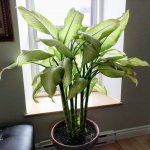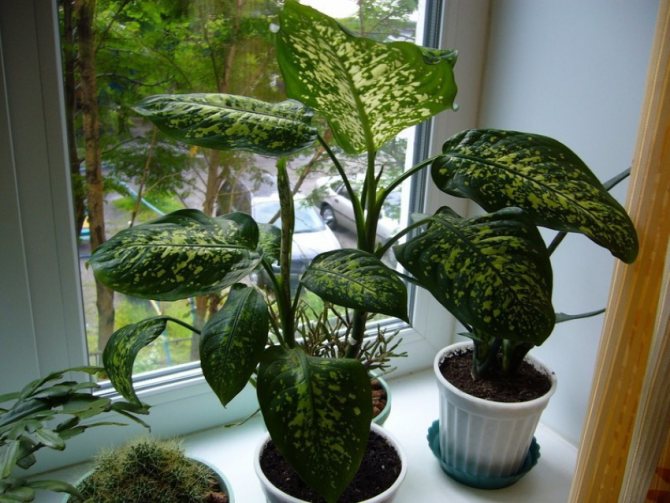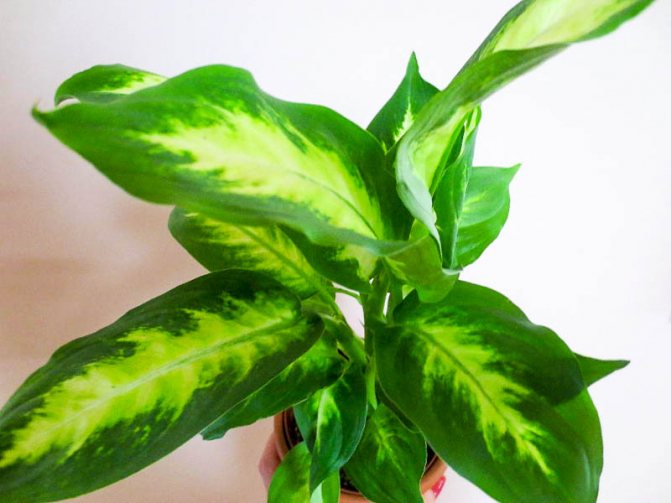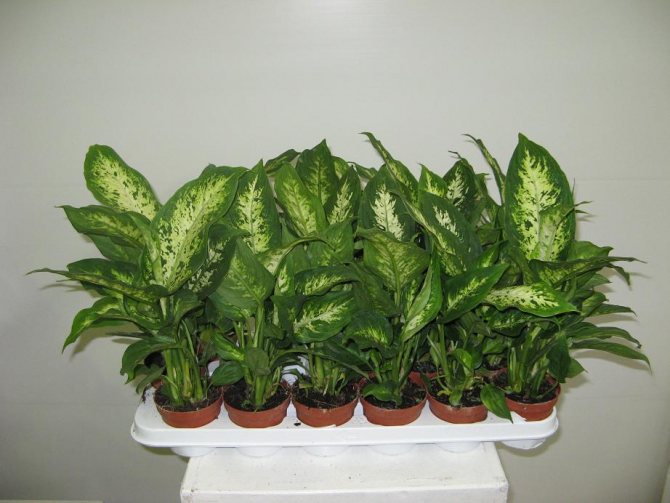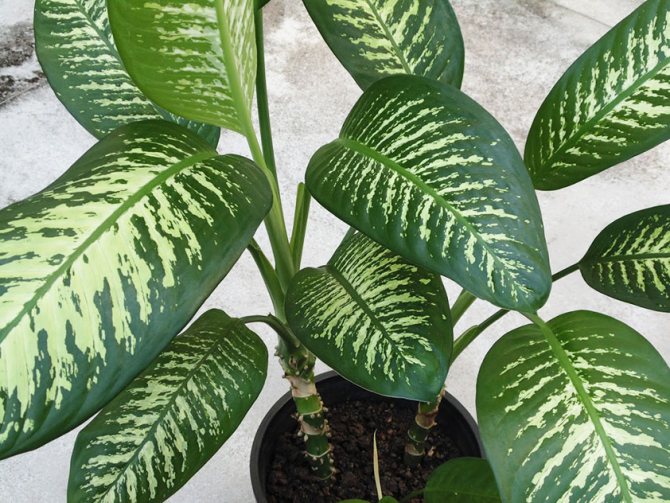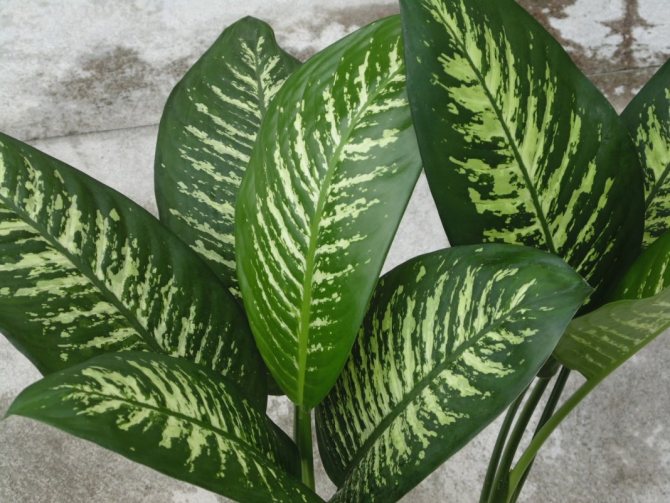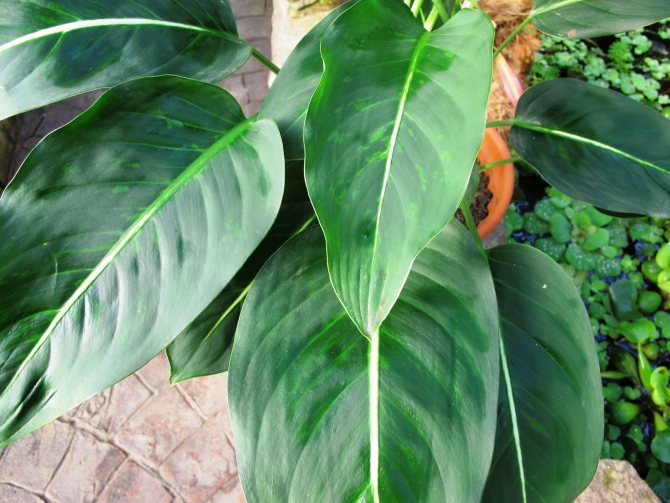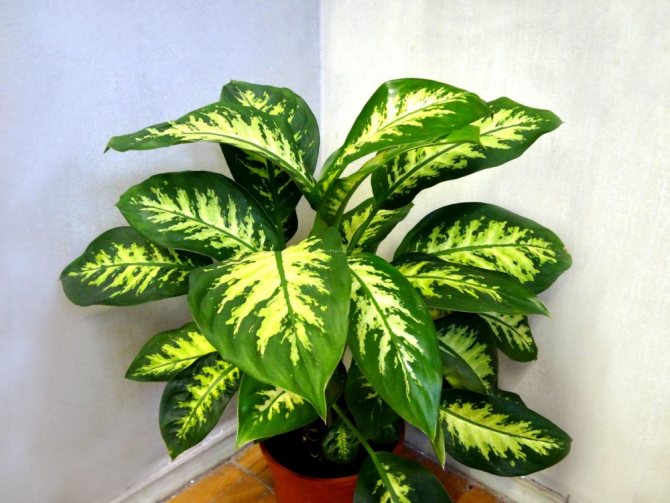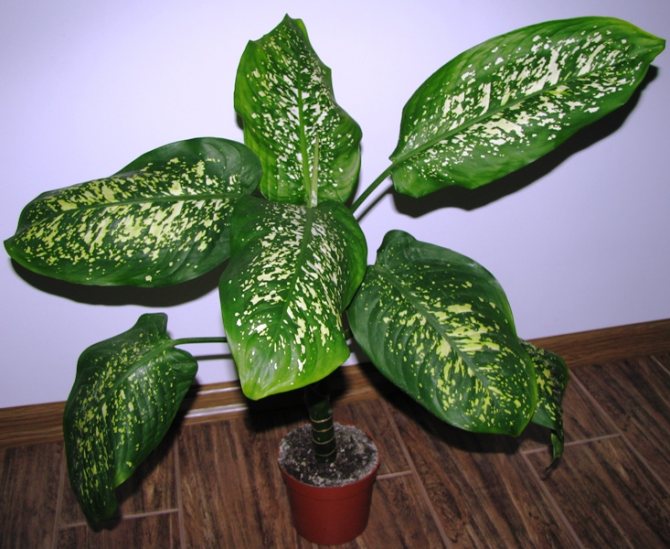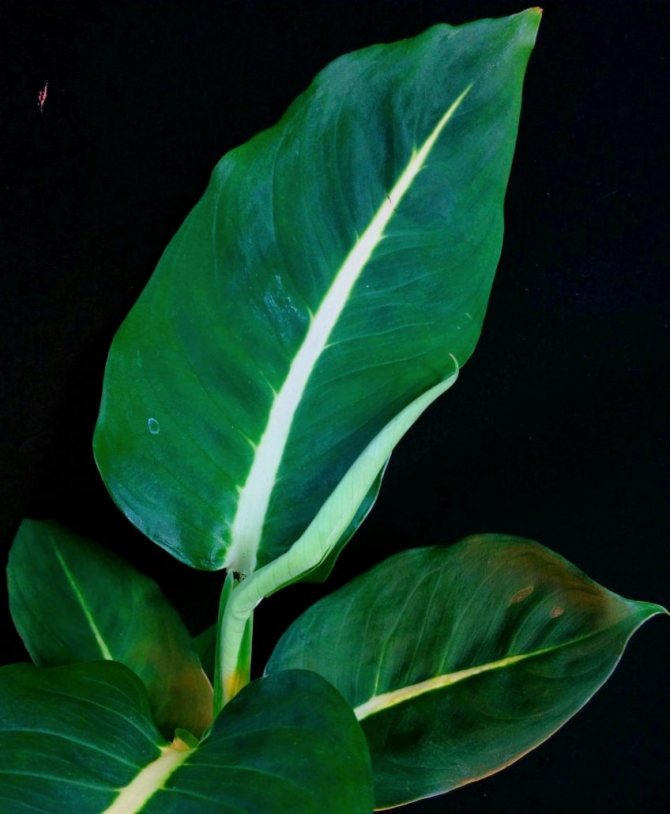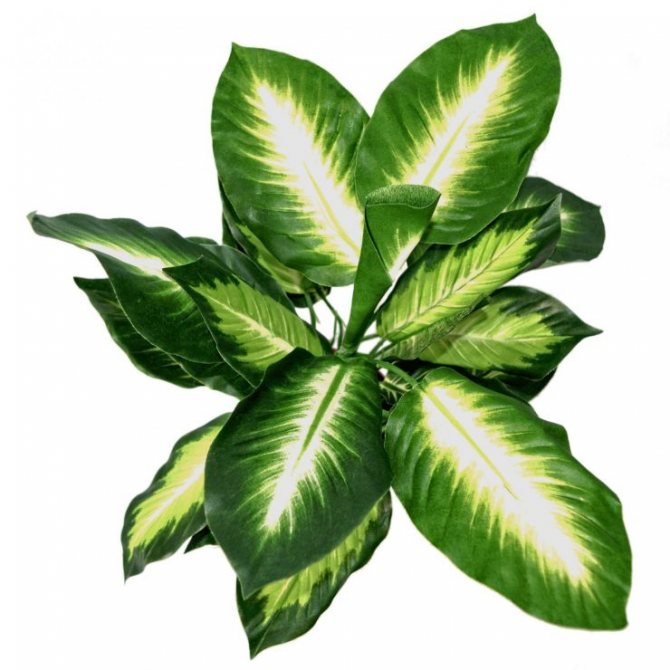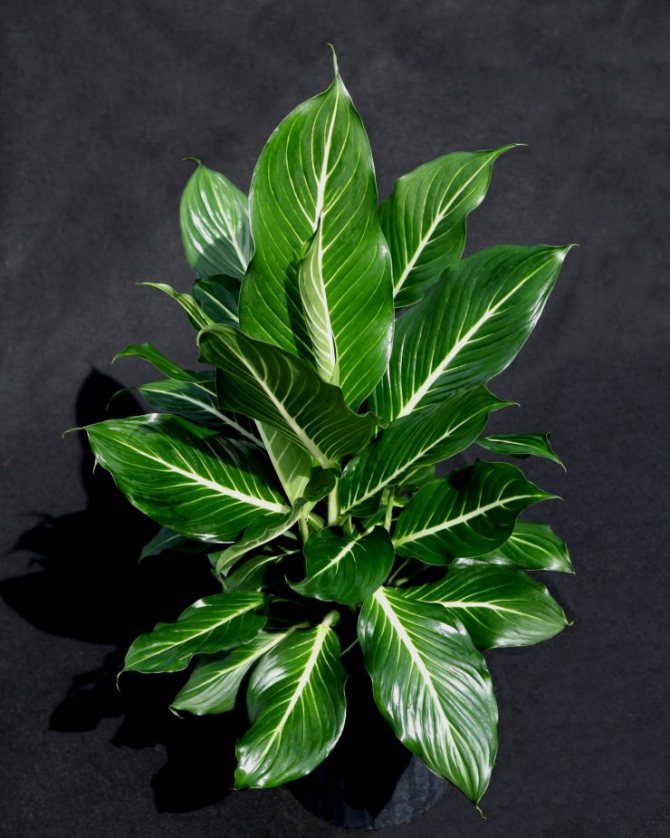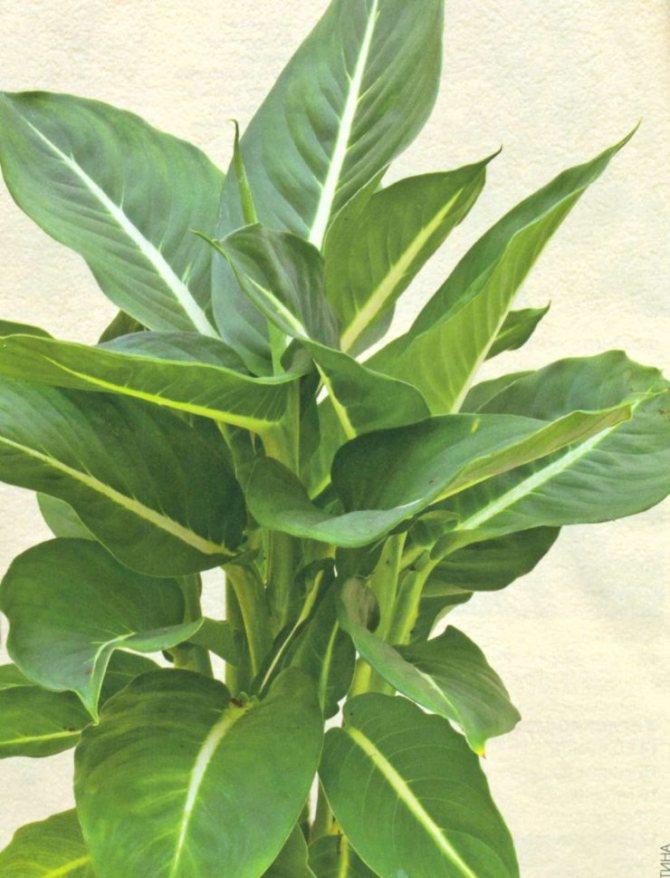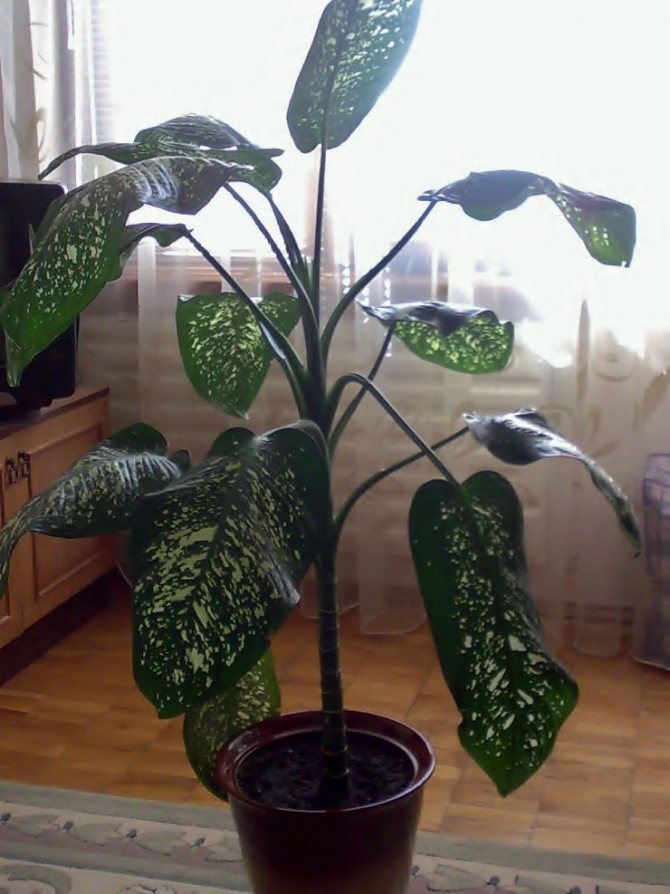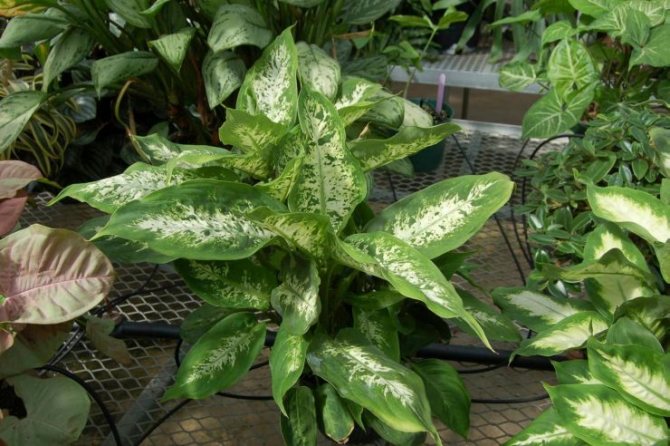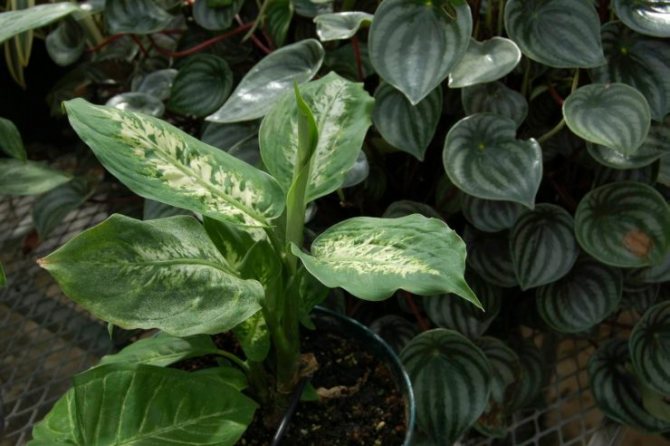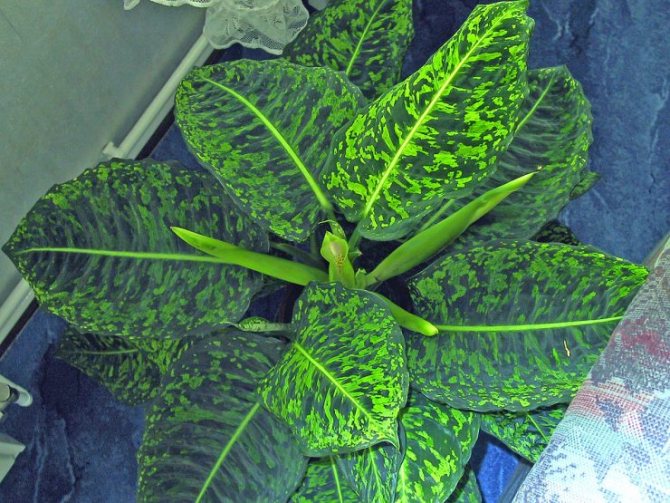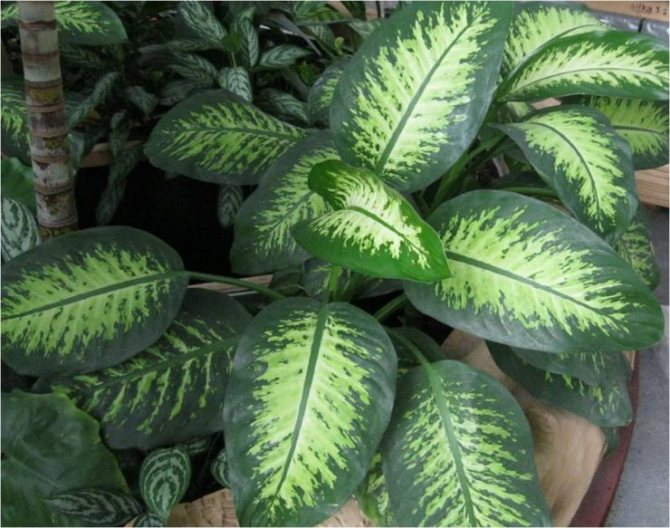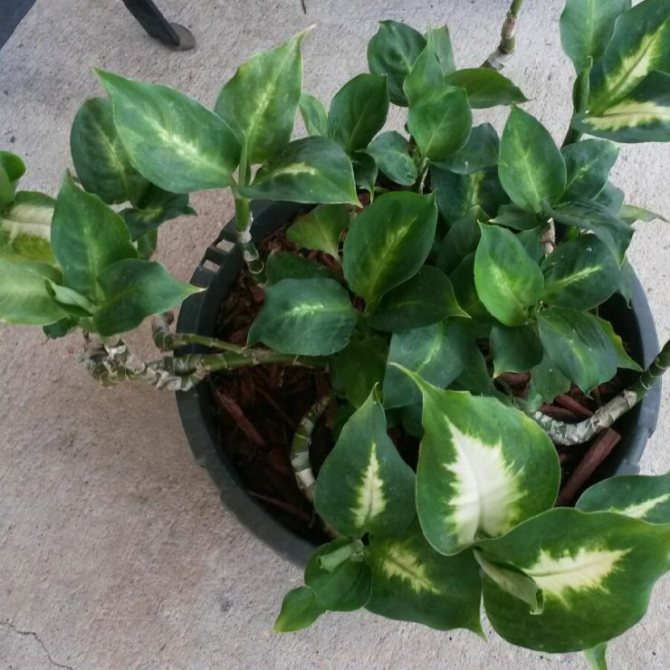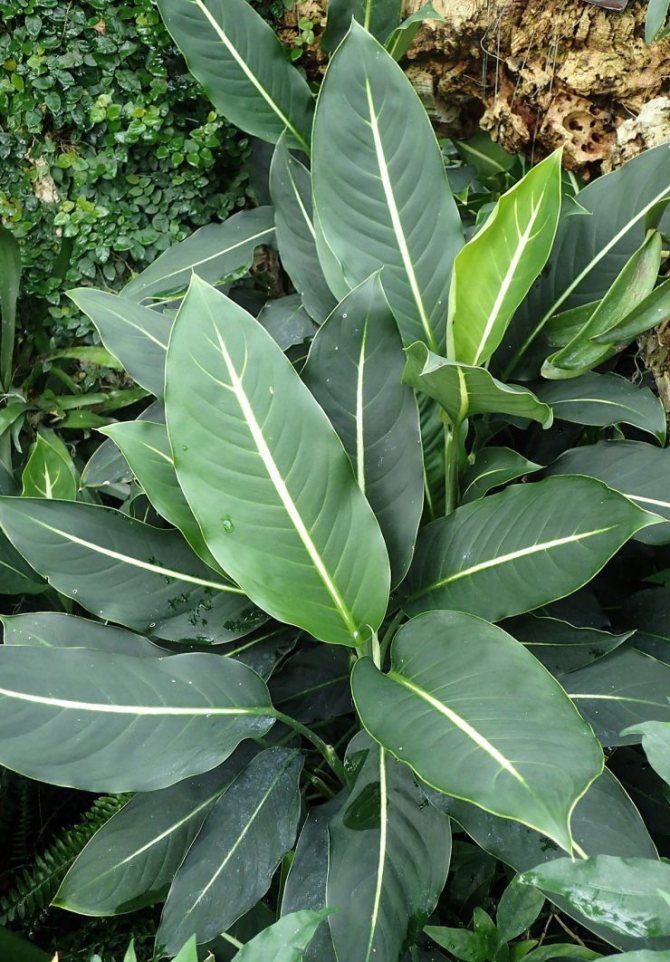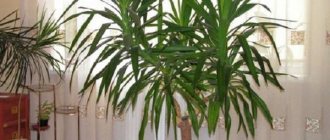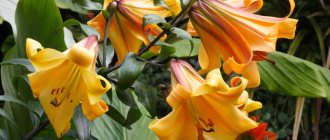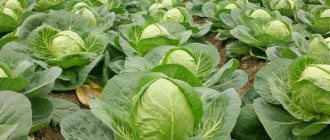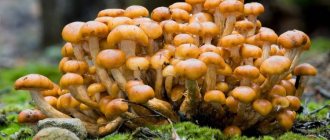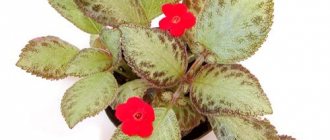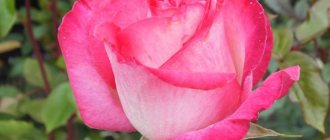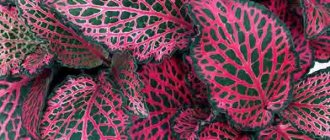Dieffenbachia (Dieffenbachia) is a deciduous crop from the Aroid family, with a straight stem and large elongated foliage. The Austrian botanist Heinrich Shotu is considered the discoverer of Dieffenbachia. But the plant is named after the Viennese gardener J. Diffenbach.
Dieffenbachia is characterized by very rapid growth. In 2 weeks, she is able to throw out 1 sheet. After a short time, the plant can stretch up strongly, while the lower part of the stem will be bare. There are varieties that can grow up to 3 m in height. When kept at home, they try to restrain its growth, limiting the growth of roots, pinching the shoots. In general, dieffenbachia is considered an unpretentious flower. But for successful development, the right approach is necessary to it.
Care
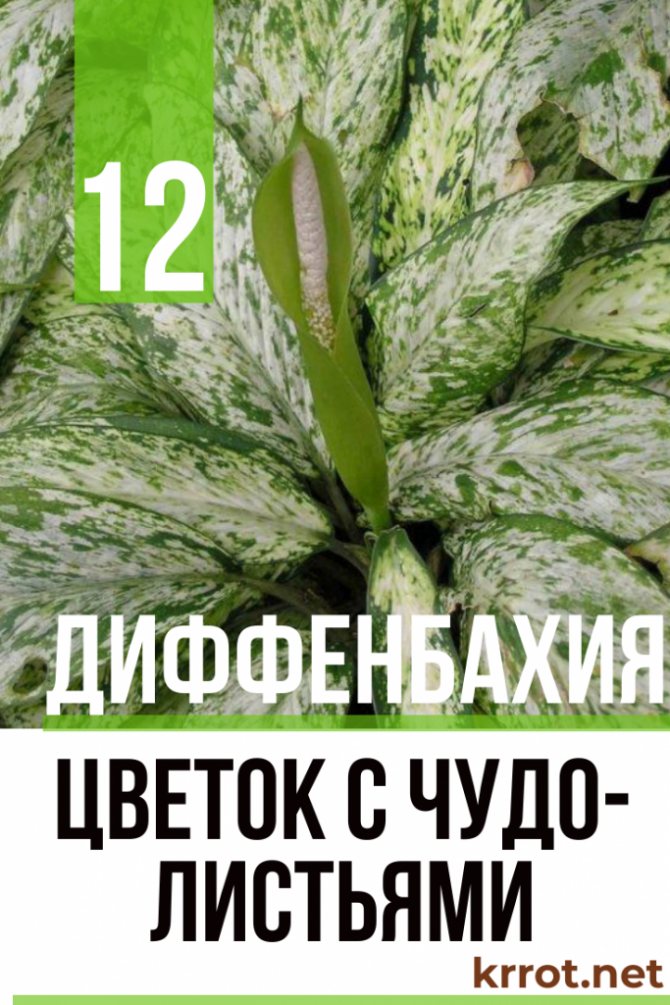
Home care
Dieffenbachia is a native of the tropics, so that it pleases with its beauty at home, it needs to create a favorable microclimate.


Dieffenbachia home
Particular attention should be paid to:
- Choosing a place
- Room illumination
- Irrigation mode
- Temperature
- Fertilizing plants
- Features of summer and winter care
- Substrate composition
- Pot selection
We will analyze each care parameter in more detail so that the spotted beauty grows healthy.
Attitude to the plant in antiquity
The first mentions of the plant have come down to us from the 18th century from Vienna, where biologists began to cultivate it in a botanical garden. Dieffenbachia arrived in Europe from South America and was named after the Austrian gardener Josef Dieffenbach. Dieffenbachia's bad reputation goes back to antiquity.
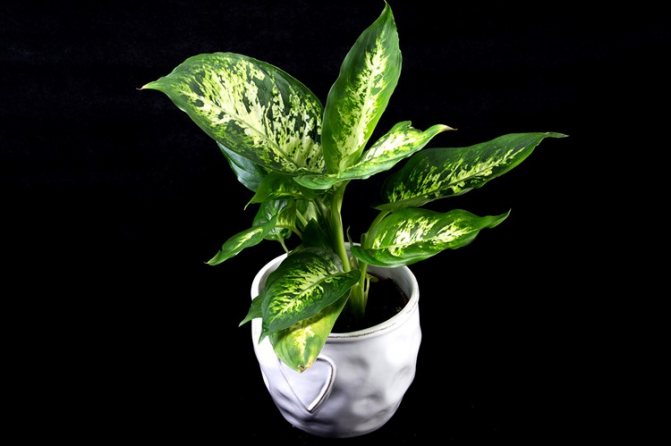

Dieffenbachia
Since this plant is poisonous, it was used as a torture device. Mostly dieffenbachia juice was used to punish guilty slaves. The venom is not toxic enough to kill an adult, but it is nonetheless potent enough to cause significant suffering.
The subject of the punishment was forced to chew the leaves of dieffenbachia, after which he could not speak due to swelling of the tongue and burns of the mucous membranes of the mouth. This procedure was extremely unpleasant for the slave, while it did not interfere with his work in any way, therefore it was used quite often.
Reproduction
After the pruning has been carried out, the leaves, the trunk and the top remain. They do not need to be thrown away. They must be used for plant propagation.
back to menu ↑
See also: Indoor flower "Bride and groom" or campanula: description, care, reproduction and possible diseases (50 Photos) + Reviews
Soil and pot selection
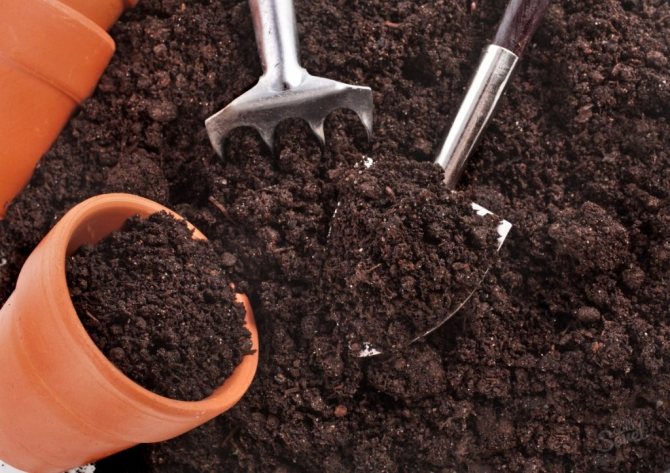

The substrate must be chosen loose, it must pass air well
In the store you can buy a special mixture for dieffenbachia. If it is dense, you can mix it with sand or peat.
In addition to the purchased soil, you can make the mixture yourself:
1You need to take 3 parts of the earth and 1 part each, sand and humus.
2Or the second option: mix turf and leafy soil, peat and sand. The proportions should be 3: 1: 1: 1.
The second version of the substrate is more dense. It is suitable for large varieties of plants.
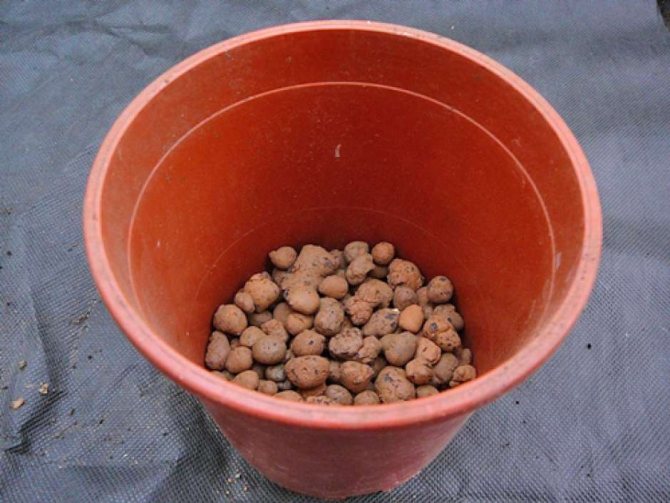

It is imperative to put drainage on the bottom.
And its bottom should be with a hole. By size, you need to choose it not very large. It should exceed the size of the root ball of the earth by 2 times.When choosing a container, you need to take into account that the plant is large, it must be stable.
back to menu ↑
See also: Dracaena marginata - care, reproduction at home (140 Photos)
Rooting types
- Rooting of the apex. Put it in a glass of water. The glass should be dark; if it is transparent, it should be wrapped in a dark cloth. The water needs to be changed every 2 days. After the roots appear, dieffenbachia is planted in a pot.
- Rooting the trunk. The long barrel is cut into pieces. You need to divide like this. So that each one has kidneys. The cut pieces must be air-dried for two days. Then put them in a pot on a moistened substrate. The kidneys should be on top. Cover the pot with foil. The optimum temperature is 25 degrees. There will be exactly as many sprouts as there are buds. When 3 leaves grow, it can be cut and rooted separately.
- Reproduction by air layers. With this method, an incision must be made on the dieffenbachia trunk and overlaid with moss. Wrap it tightly with foil on top. When the roots appear, the film is removed, and the cuttings along with the moss are planted in a prepared pot.
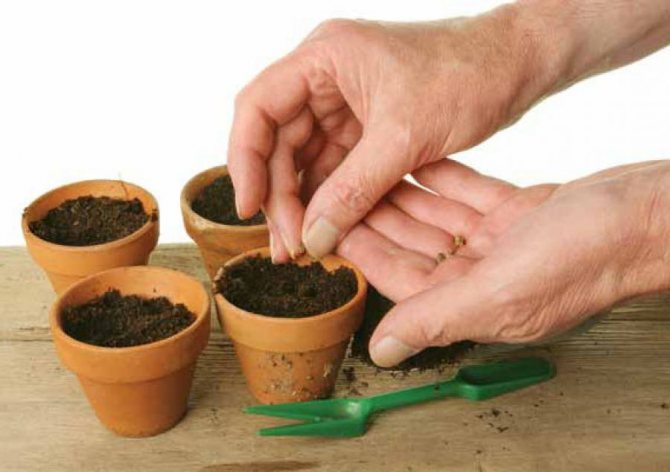

There is also a way to grow by seeds
... It is used by professional florists. Bush varieties can be propagated by dividing the bush.
back to menu ↑
See also: Euphorbia: home and garden. Description of 22 popular species and varieties, agricultural technology, plants, diseases and pests (115 Photos & Video) + Reviews
Popular superstitions and mystical properties
What indoor plants can not be kept at home
Dieffenbachia and why it is impossible to keep it at home is associated with a lot of popular superstitions, mostly negative.
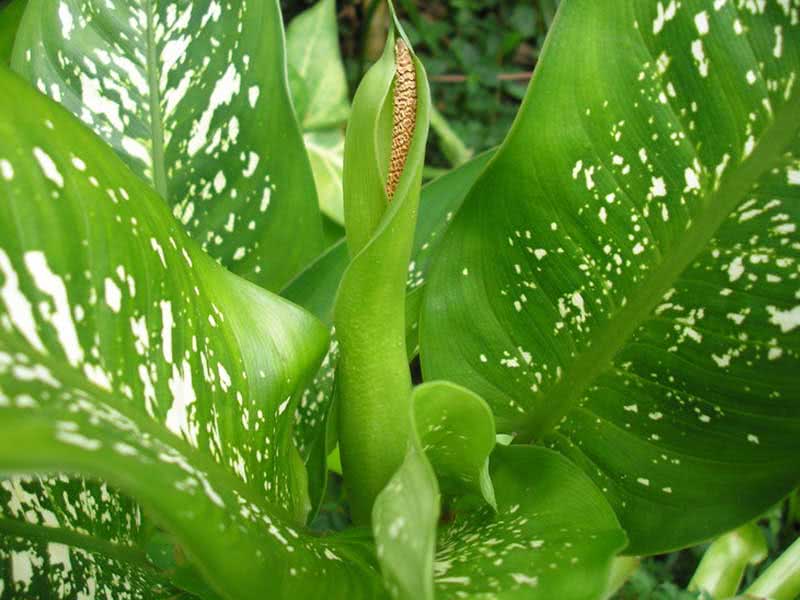

Dieffenbachia flowers are not the most noticeable
According to signs, the plant should not be bred primarily by women. Dieffenbachia is popularly considered muzhegon. She even has other names - Widow Flower or Celibacy Flower. It is believed that after the appearance of a plant in an apartment, a man disappears from it. Supposedly dieffenbachia weakens the male energy and forces the representatives of the strong half of humanity to leave.
One can argue for a long time as to whether Dieffenbachia is a muzhegon or not, but such a superstition exists, and many believe in it. Nevertheless, a huge number of quite prosperous families remain in the world, in whose apartments this indoor flower grows, and who live well without experiencing any problems.
Those who are concerned about the money issue may be interested to know that dieffenbachia contributes to the emergence of financial difficulties. However, it is likely that such a folk fiction is somehow connected with the departure of a man from the family.
Some keep the flower in the house as a kind of natural barometer. The plant anticipates the onset of prolonged precipitation: heavy snowfall or prolonged rains, and begins to "cry", getting rid of excess moisture, which may be destructive for it.
Interesting! Dieffenbachia bloom lasts only a couple of days. It is recommended to cut the flowers immediately after they appear, so that the plant does not waste its strength and does not begin to shed beautiful foliage.
Transfer
When the roots fill the pot, the dieffenbachia is transplanted. The signal will be roots peeking out of the drainage hole at the bottom of the pot. It should be carried out once every 3-4 years. Once every 2 years, the top layer of the earth is removed and a new substrate is added.


The pot is selected more by a few centimeters
It is filled in the same way as when planting a young plant. Dieffenbachia is transplanted with an old clod of earth. The drain must be new. A new potting mix is added to the sides.
The best time to transplant is during the cold season. In winter, the plant is dormant. It will more easily handle the stress of changing the pot.
After transplanting dieffenbachia, top dressing is not necessary... Especially if purchased land was used. The first fertilizer should be given to the plant no earlier than a month later.
back to menu ↑
See also: Walnut: benefits and harms - how to stay healthy. Jam, tinctures (on shells and partitions), features for women + Reviews
Useful properties of the widow's flower
Dieffenbachia is an ornamental houseplant of the aroid family. The flower is also called muzhegon or widow's flower. The appearance and size are due to their natural habitat. The peculiarities of the American tropics allow only plants with large leaves and gigantic growth to survive. Indoors, the flower does not fight for moisture, as in natural growing conditions, extracting it by collecting leaves.
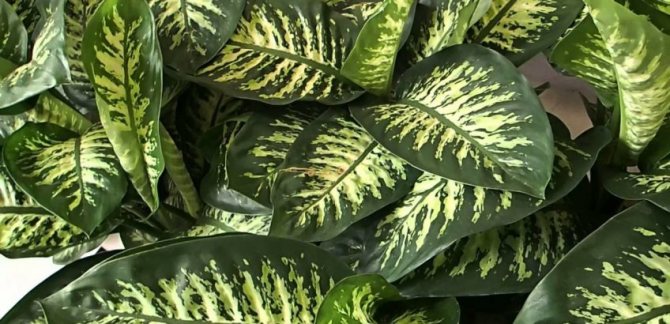

Beneficial features:
- Humidifies the air. Especially important during the heating season. In the presence of one or two adult plants, it is much easier to breathe in winter, which is very important for children with allergies.
- Cleans the air. Relieves human lungs from the consumption of substances such as benzene, xylene, formaldehyde. Those who live near a motorway or an industrial plant definitely need dieffenbachia in their bedroom, nursery, or kitchen!
- Eliminates harmful bacteria from the indoor atmosphere. The likelihood of illness during outbreaks of viruses and influenza is reduced to minimal levels.
Bloom
Dieffenbachia rarely blooms at home. It is valued not for flowers, but for beautiful leaves. The flower develops in spring in April-May. It develops for about 2 weeks and blooms for 3 days. It has the shape of a cob.
Florists advise removing the emerging flowers. They are ugly, and they take a lot of strength from the plant.
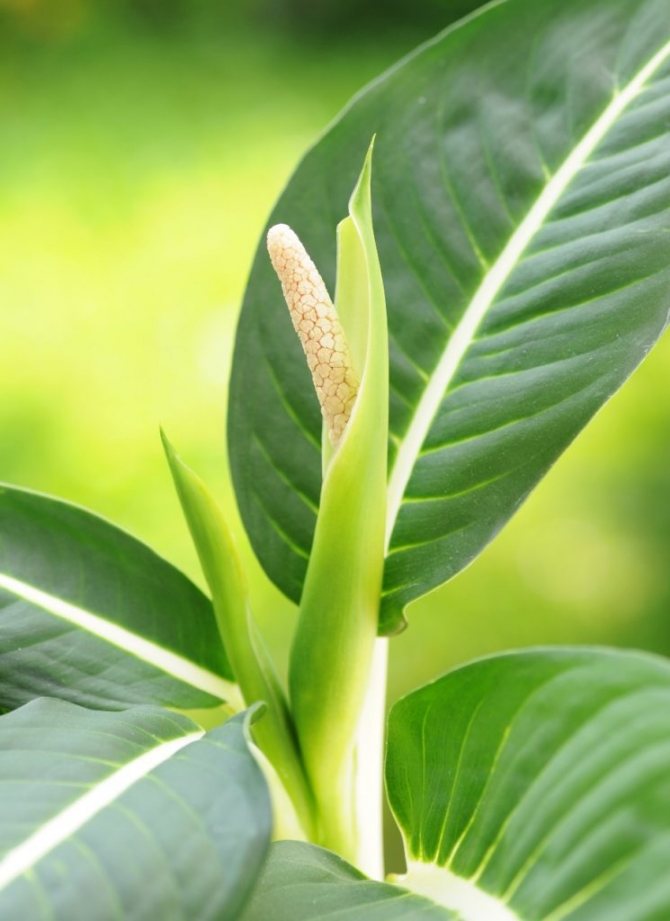

It smells of plastic with sweetish notes. If you leave it, then it is better to take it out of the living space.
If you want to see your Dieffenbachia blooming, you need to create a stressful environment for it. To do this, put in a well-lit place, but deprive it of fertilizer and watering. You need to torment the plant until the leaves sag.
Then it needs to be revived. Place in a container of water until the leaves come to their senses and a bud appears. After such a procedure, she should start.
back to menu ↑
See also: Perennial flowers (33 main species): garden catalog for a summer residence with photos and names | Video + Reviews
Dieffenbachia: muzegon or not
Although it is generally accepted that dieffenbachia reduces male energy and causes a man to feel unwell, there is no compelling case for the objectivity of such a belief. It is likely that the representatives of the beautiful half of humanity simply justify their failures on the personal front by the presence of this flower in the apartment.
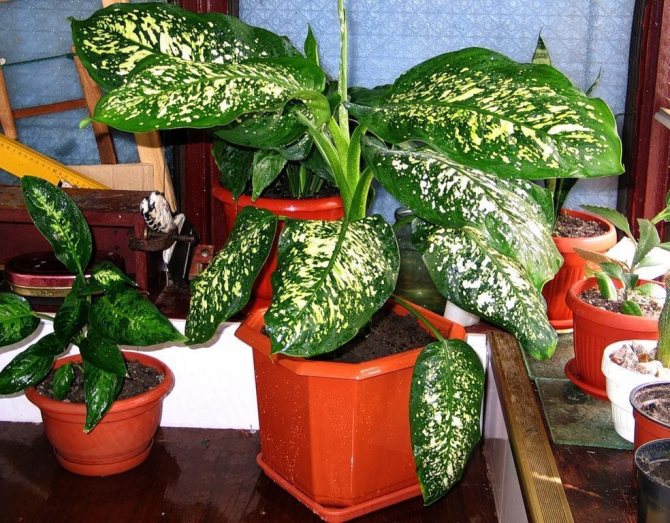

The superstition that dieffenbachia scares off men is very common
Is it safe to grow dieffenbachia at home
Dieffenbachia is a poisonous plant. A wild plant needs protection from pests, poisonous juice meets this need.
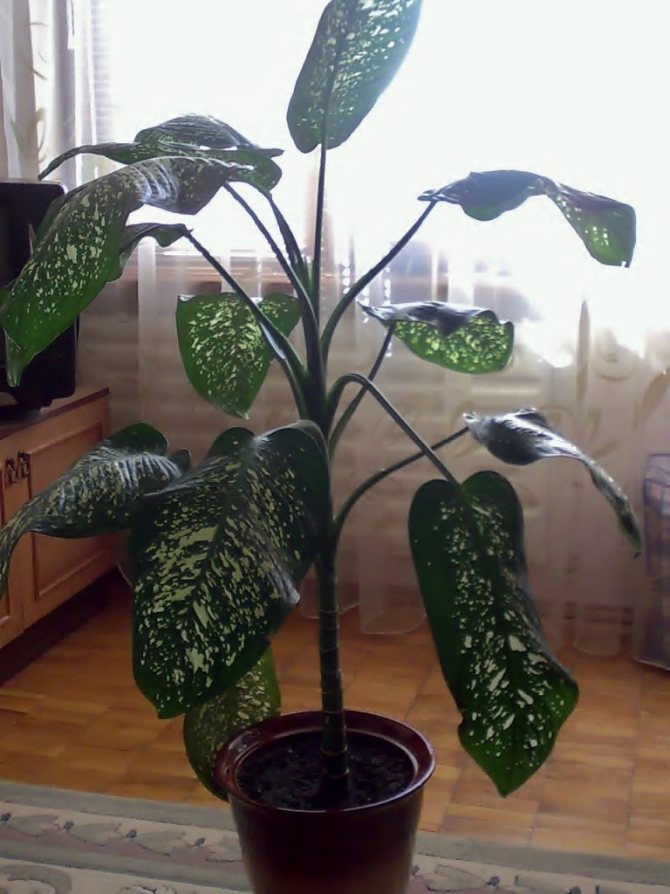

At home, it will not harm if you handle it correctly.
The pot should be out of the reach of children and animals. So that they do not accidentally try her leaves, which attract with their brightness.
Even a small piece of dieffenbachia can cause burns to the oral cavity and respiratory tract. If it enters the stomach, there is a risk of internal bleeding.
It is better to abandon the plant when a cat lives at home. It is very difficult to remove anything from them. Since they can climb into any hard-to-reach place. Its juice, entering the esophagus and stomach of a pet, can be fatal.


The plant is dangerous for allergy sufferers. With individual intolerance, it can cause heart failure.
There is a popular belief about dieffenbachia that it scares men away from the house. It is popularly called the “widow's flower”. Allegedly, her mistress, even if she creates a family, will not be able to give birth.
Another interesting fact about the plant. In Africa, he was nicknamed "the dumb rod".In a slave society, its leaves were forced to chew on slaves as punishment. The milky juice affected the larynx and mouth. The man could not speak. So they punished for arguing with the owner.
Despite beliefs and poisonous properties, it is common in homes. It is grown and cherished. The main thing is to observe all precautions in this process.
back to menu ↑
Read also: Hosta: description, types and varieties, planting in the open ground and care, possible diseases (120+ Photos & Videos) + Reviews
The danger of a flower to humans
The plant can store a certain danger in itself. Therefore, it is imperative to deal with the questions, the dieffenbachia flower is dangerous for a person, and whether it is worth keeping dieffenbachia in the house.
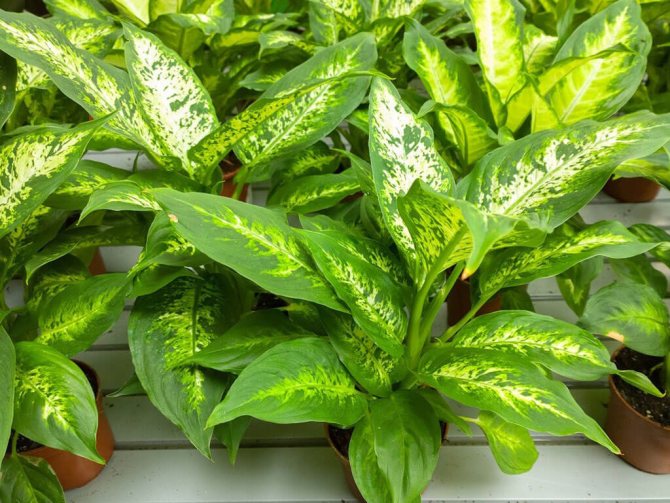

Dieffenbachia is a bright, beautiful, but dangerous plant
The milky sap of the plant contains toxic substances, after direct contact with which, burns, dermatitis or allergies may develop. If the juice of a poisonous house plant dieffenbachia gets into the eyes, it will inevitably cause tissue swelling, conjunctivitis, or even temporary blindness. On contact with the oral mucosa, swelling of the throat develops, due to which the ability to speak is temporarily lost.
In some cases, the answer to the question of why dieffenbachia is dangerous is that the plant is fraught with a high allergic risk. An allergic reaction is expressed in the same way as to any other irritant. For example, dust, berries or cat hair. A person has a runny nose, cough, itching, watery eyes, the skin becomes covered with red spots. Usually it does not come to anaphylactic shock, but in some cases bronchial asthma may develop.
Benefit
Its benefit is expressed in the purification of the normalization of the air in the room. Dieffenbachia absorbs excess moisture from the air. During the heating season, on the contrary, it gives off moisture, moisturizing the environment. Thanks to it, a comfortable atmosphere for breathing is created in the house.
.
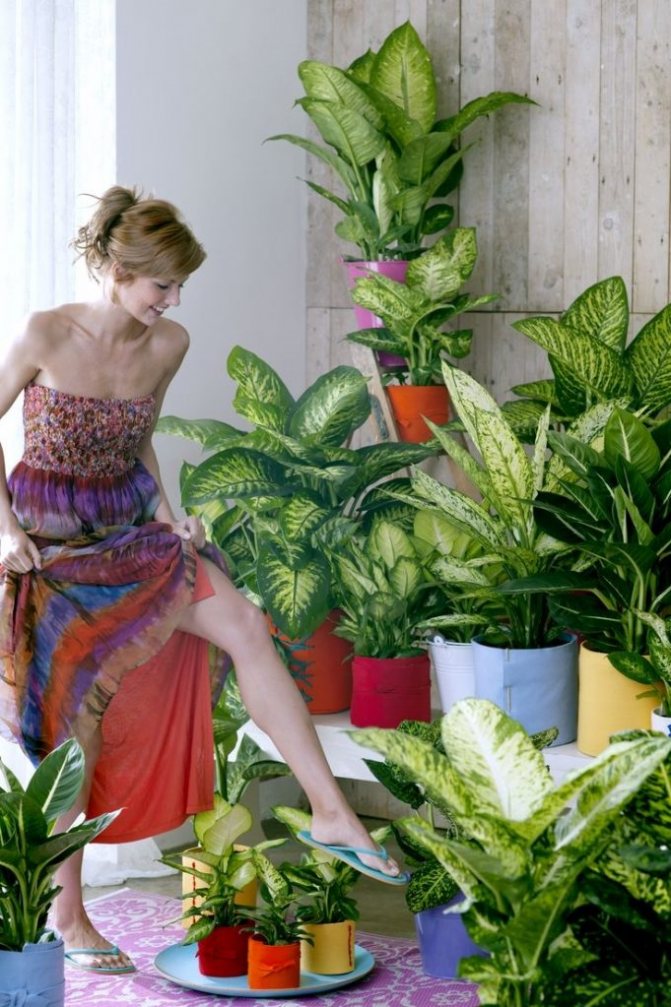

The second indisputable advantage is the release of oxygen
One bush can provide them with a small space. A few plants will replace the whole greenhouse.
This plant absorbs chemical elements. One of them is formaldehyde, which is found in furniture. Air purification is a vital factor, especially for the inhabitants of megacities.
Experienced growers recommend growing Dieffenbachia in offices. It will increase your efficiency and make your workflow more comfortable. With the help of phytoncides, it absorbs pathogenic bacteria, thereby preventing them from spreading and protecting human health.
The pluses include decorativeness. The flower will decorate the interior with its large spotted leaves. It will make your home more comfortable.
back to menu ↑
See also: Lemon: description, care, growing from the seed at home, recipes for vitamin juice and lemonade + Reviews
The positive properties of dieffenbachia
Despite the many negative qualities of dieffenbachia, it can also be beneficial. The flower, like Tradescantia, is a natural humidifier. The wide leaves of the plant constantly evaporate moisture. Near dieffenbachia it is easier to breathe, thoughts become clearer.
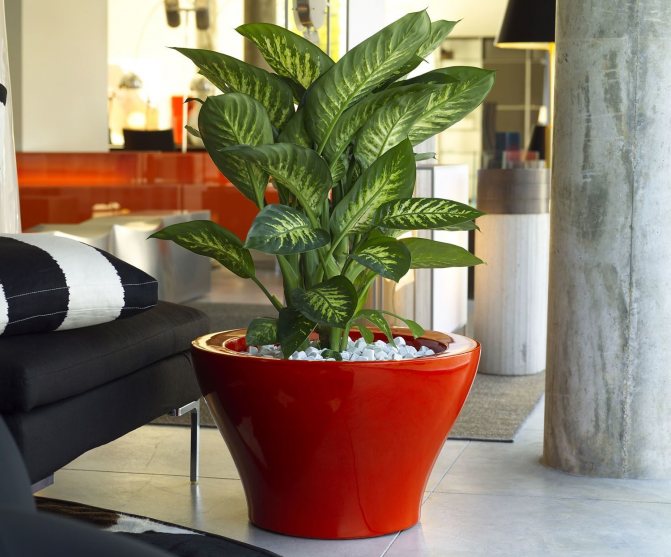

Proper plant care involves constant spraying of the leaves, which also increases the humidity level in the room with dieffenbachia.
The flower is great for people suffering from dust allergies. Unlike many other ornamental plants, dieffenbachia leaves have a smooth surface. It is convenient to collect dust from them during regular cleaning.
Thanks to the phytoncides contained in dieffenbachia, the plant is able to purify the air. The immune system of the flower protects against pathogenic bacteria and microorganisms, destroying them. At the same time, the plant also protects people who are nearby. Therefore, dieffenbachia can often be found in hospitals and other medical institutions, as well as in crowded places.
Interesting!
A very valuable quality of dieffenbachia is its ability to cleanse the room from formaldehyde. The presence of chemical gas is especially acute after repair work. The flower quickly removes unpleasant substances, making the air in the room cleaner. Recently, the use of the plant as a natural air purifier has been gaining momentum. Environmentalists advise to grow a flower in houses located in ecologically disadvantaged areas.
On the forums dedicated to the discussion of dieffenbachia, the owners of the plant talk about the positive effects of the flower. Next to him, women feel comfortable and cozy. Some growers claim that dieffenbachia helped them lose weight.
Even in the signs of a flower that carry a negative meaning, you can find positive moments. So the plant does not pose an energy hazard for elderly couples and women who do not seek to get married. Signs about the property of Dieffenbachia to promote business and increase efficiency make the flower indispensable for men who spend a lot of time at work.
Diseases and pests
Despite the simple care, dieffenbachia requires careful adherence to the rules. Their violation can cause bush disease. The disease can also be caused by various pests.
To save a plant, it must be inspected regularly.in order to identify the problem in time and begin to deal with it.
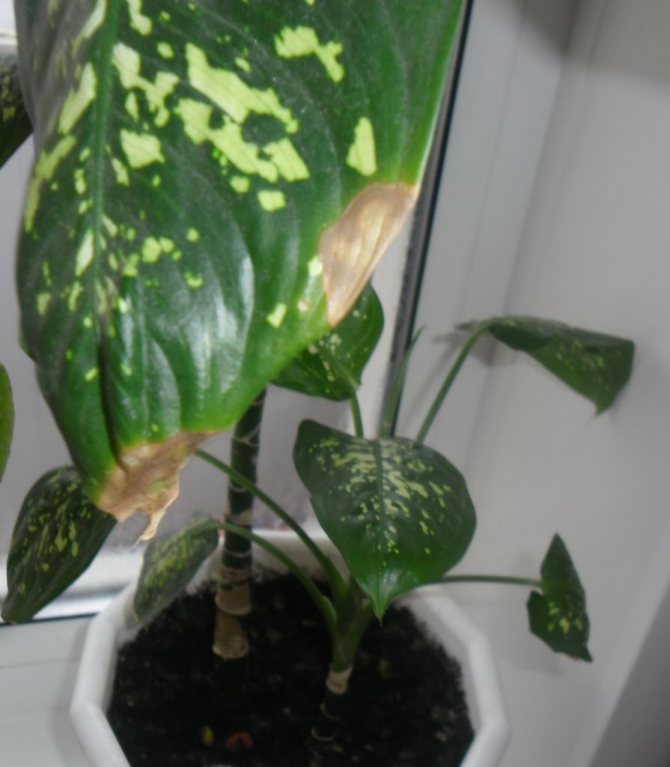

Sign of a sick plant
The first danger comes from fungi. Dieffenbachia can be affected by three fungal infections:
- Viral
- Fusarium
- Anthracosis
A number of factors that say that you need to treat the bush:
- Falling foliage
- Rotting root system
- Lethargy Dieffenbachia
- A gray bloom appears on the leaves
- The edge of the sheet dries
- White bloom on potted substrate
The first measure should be soil replacement... In order to kill the fungus, it is recommended to water it with a weak solution of potassium permanganate. Then you need to process the flower itself.
Remove damaged leaves. Treat all sections and wounds with activated carbon.
Dieffenbachia can be attacked by mealybugs, spider mites, aphids, and scale insects. If there are few pests, then you can remove them with a sponge. Before the procedure, it must be soaked in soapy water.
When a flower is severely affected by insects, special means must be used. These include karbofos and actellic. They are diluted with water. Ratio: for 1 liter of water 15 drops of the product.
back to menu ↑
See also: Ficus Benjamina (100 Photos) - home care, varieties, reproduction, transplantation, diseases (Video) + Reviews
Care errors and their elimination
Problems in growing crops and methods for their elimination:
| Problem | The reasons | Decision |
| Yellowing of leaves | Sunburn | Place the flowerpot in a bright place, but not in direct sun |
| Lethargy and curling leaves | Poor drainage, root decay | Remove damaged roots, transplant into new loose soil with good drainage |
| Drying leaves | Lack of moisture, dry air | Spray the leaves regularly, water as needed, prevent the earthen coma from drying out |
| Lack of growth | Watering with cold water, poor lighting | Move the flowerpot to a bright place, pour with warm water |
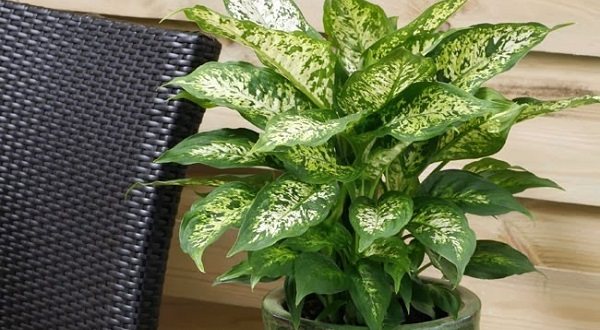

Choosing Dieffenbachia in the store
When it is decided to grow dieffenbachia at home, you need to choose it correctly when buying.
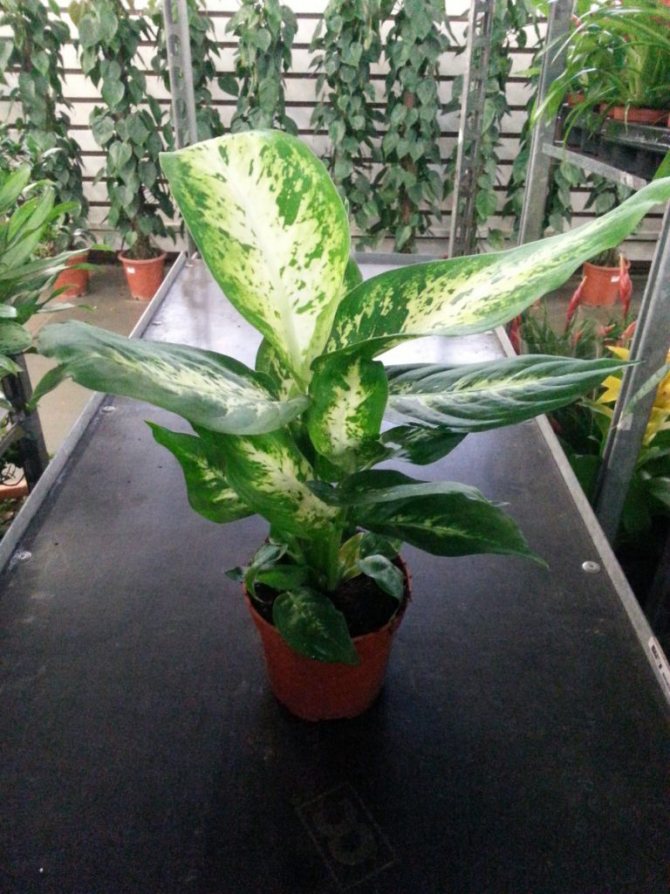

The bush should be strong and healthy, and the leaves should be juicy and bright.
They should not have yellowness and dry areas.
Be sure to pay attention to the bottom surface of the sheet. It is there that pests are hiding. By bringing them home, you risk infecting all the plants.
If the substrate is wet and the plant is drooping, then the root system is damaged by rot. It will be very difficult to reanimate.
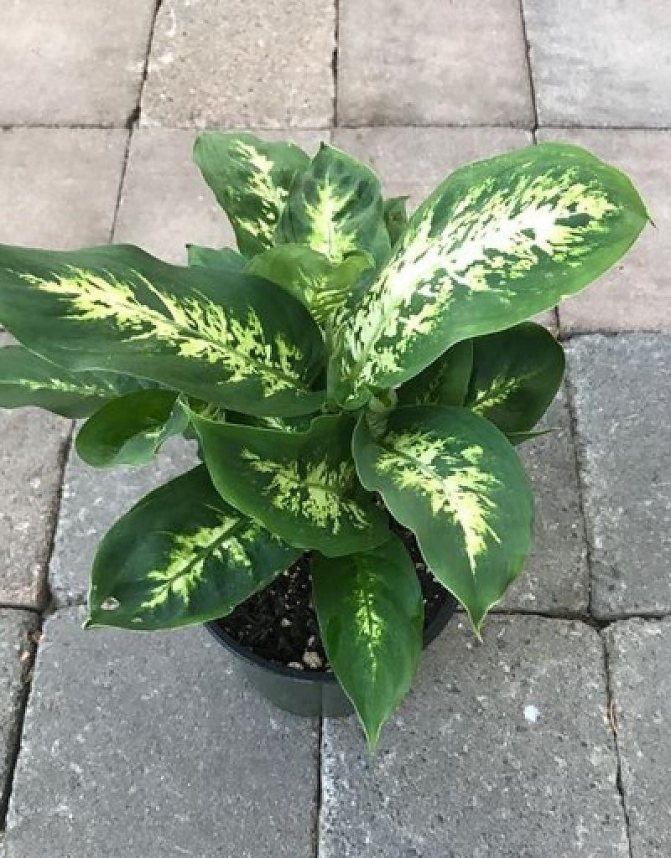

Dieffenbachia bought in spring adapts faster to new conditions
The habituation period will take up to three weeks. To help her, you need to spray the foliage often.Watering, on the contrary, should be reduced.
Why dieffenbachia blooms
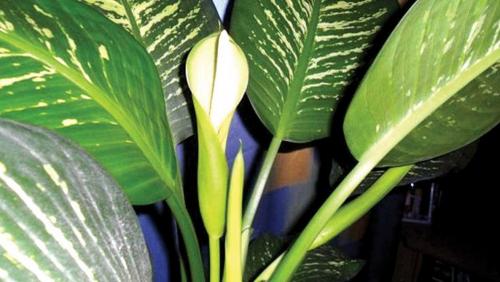

Flowering is a rare occurrence in this plant. It was also overgrown with folk signs. The main thing is a warning. Signals about imminent negative events or problems associated with men in the family.
Blooming Dieffenbachia symbolizes change. All that needs to be done at this moment is to prepare mentally for the blows or twists and turns of fate, which will be resolved faster if the matter is approached calmly and carefully.
Oersted (D. oerstedii)
The shape of the leaves is close to oval, sometimes cordate or pointed. The length of the leaf plates reaches 35 cm.
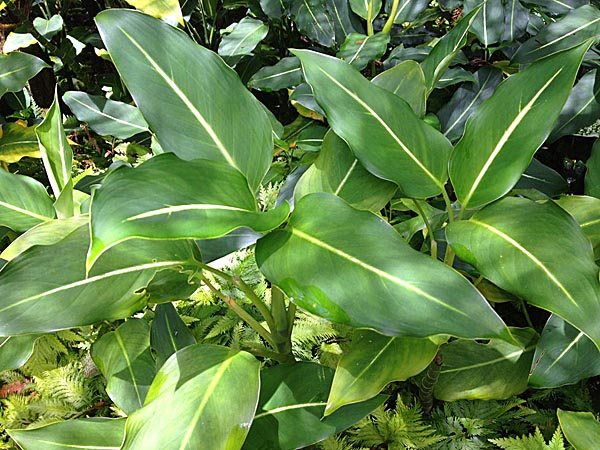

The most common color is saturated green, but there are varieties with both dark leaves (gray-green with a metallic sheen) and very light (light green). A light stripe is clearly visible along the central vein.
Dieffenbachia watering mode
During the period of increased growth of dieffenbachia, it needs to be watered with large portions of water, but in winter the permissible amount of moisture is much reduced.
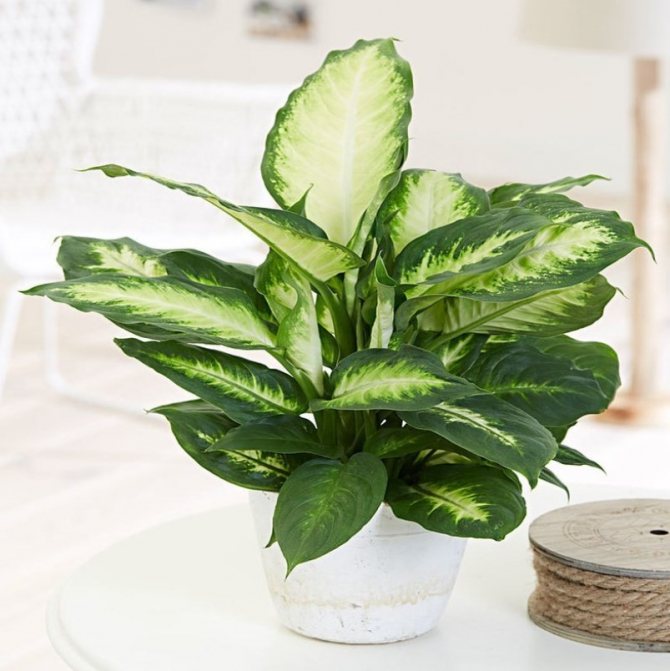

It is necessary to ensure that excess liquid does not accumulate in the soil and does not stagnate. To avoid this, you can either check the dryness of the soil with your finger, or you can purchase a special device for measuring soil moisture.
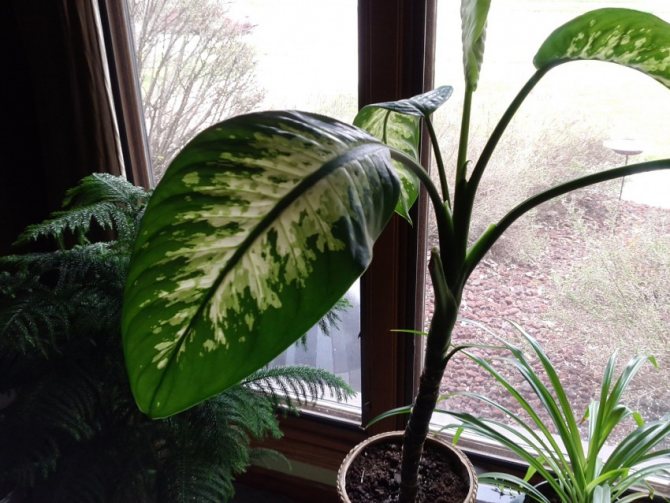

- How to care for tomatoes - planting, watering, feeding and the main nuances of growing. Tips and secrets of tomato care for beginners (110 photos and videos)


Feeding tomato and cucumbers with yeast: recipes and video instructions on how to properly feed vegetables with yeast (105 photos)
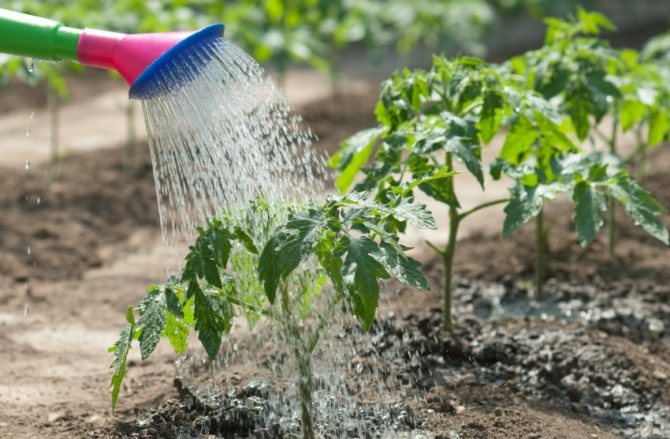

Boric acid for tomatoes: methods of application as fertilizer for the garden and vegetable garden. Expert advice and detailed technology for the application of boric acid to tomatoes (90 photos + video)
Varieties
There are more than 40 species of this plant. In this section you will find all the information about the varieties of Dieffenbachia, photos and names. According to their form, it is customary to divide them into two subgroups: tree-like and bush:
- Arboreal - such plants have a strong, without branches, stem. As it grows, the lower leaves are lost, and pretty soon the silhouette of Dieffenbachia begins to resemble a palm tree. This type includes, for example, D. painted (D. picta) and D. lovely (D. amoena).
- Shrub - has many stems, leaves are located close to the ground level. The plant is characterized by lush greenery and looks like a bush.
What you need to remember and be able to do when growing a houseplant
Knowing the strengths and weaknesses of houseplants will help determine whether it is worth spending time and money on your chosen flowerpot or not.
Dieffenbachia will delight you with fast growth and durability - these are good qualities if you want to plant greenery on a permanent basis as soon as possible. She is not very demanding in leaving. Provide the necessary microclimate, regularly and correctly water, fertilize, transplant plants, wipe dust from wide leaves. To avoid allergic and other troubles, do not allow direct contact of plant parts with the skin. Use gloves when replanting, removing old leaves, pruning and even dusting, and wash your hands very carefully with soap and water at the end of the job.
2.Description - what dieffenbachia looks like
The plant got its name in honor of the chief gardener of the botanical garden in Vienna, Joseph Dieffenbach. The Dieffenbachia genus consists of about 30 species of perennial evergreen herbaceous plants with a powerful root system. Plants are grown for their beautiful foliage.
Stems erect, unbranched are soft, wide, succulent, in adult plants they bear traces of fallen lower leaves.
Leaves up to 25 cm long, slightly hanging on petioles.
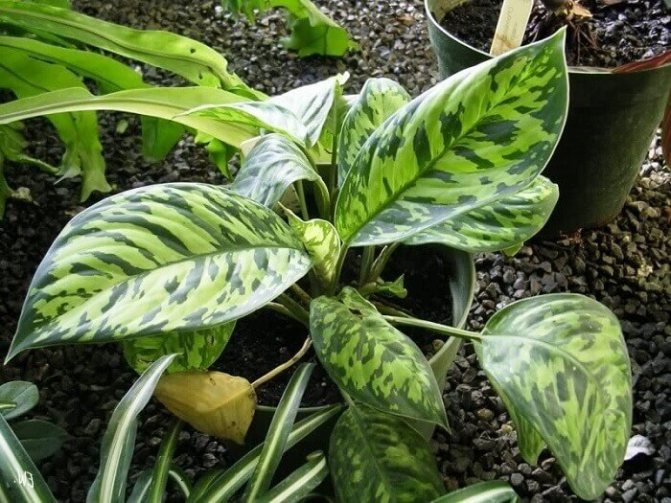

The leaf blades are green, in some species with a variety of yellow, cream and white markings, sometimes even almost completely white with a thin green border around the edge. As the plant ages, it can lose its lower leaves, while exposing the lower part of the stems.Bushes bloom in culture quite rarely and only with proper care.
Flowers greenish and white, odorless, nondescript, therefore they are not of particular value. Inflorescence - an ear (ear) surrounds a small light green veil. After flowering, the plant forms rounded red berries.
↑ Up,
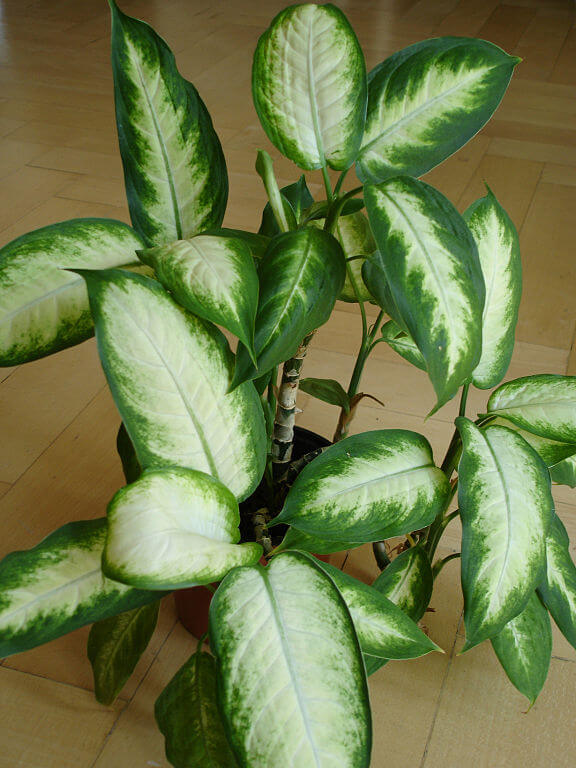

Dieffenbachia at home - height... The plant can reach 1.8 m... heights when kept in containers. The growth rate and final size of the plant depends on the species.
New hybrids can remain compact throughout their life and not exceed 30 - 60 cm.
↑ Up,
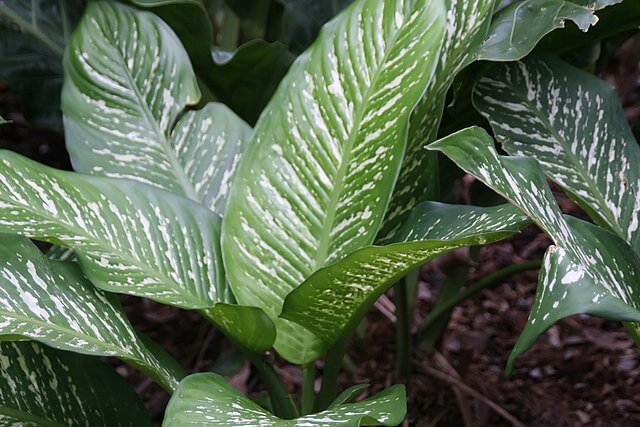

Air cleaning
Each of us must have furniture in the apartment. Did you know that formaldehyde and other harmful substances that release toxins into the air are used in the manufacture of tables, chairs, wardrobes and beds?
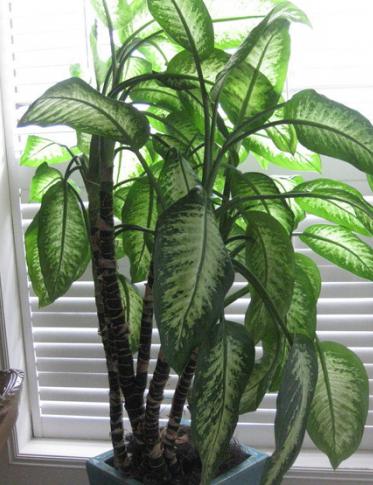

Dieffenbachia perfectly absorbs them, releasing oxygen. The plant also cleans the air from xylene and toluene, absorbs harmful vapors that are released when working with household chemicals.
It is not surprising that this home flower is recommended to grow to all those who live near large industrial enterprises, highways, in megacities.
Skin burn
The poisonous juice of dieffenbachia comes into contact with unprotected tissues during the processing of the plant, cutting off the leaves, stems, peduncles. Therefore, in order to avoid poisoning, any interaction with the flower must be carried out with gloves.
Symptoms will resemble skin burns:
- sharp pain;
- burning, itching;
- redness, swelling of the place of contact with the poison.
How to treat a skin burn from dieffenbachia? It is enough to quickly rinse off the juice with running water, including rinsing your mouth and nose. Do not rub your skin in an attempt to completely remove the corrosive substance. With severe pain, you can take a drug with an analgesic effect.
Types of dieffenbachia with photos and names
There are more than 60 varieties of this plant. They make up two large groups: bush dieffenbachia and tree-like. The first type is plants with many lateral branches.
Growing up, they resemble bushes. The second species has a strong, thick, high stem. The lateral branches of such dieffenbachia gradually die off, the plant becomes like a tree with a crown.
Most loved by flower growers are spotted, otherwise painted (Dieffenbachia Maculat), and variegated (Dieffenbachia picta, or painted). However, besides them, there are many more beautiful forms of dieffenbachia.
Variegated, or painted
International Latin name: Dieffenbachia Picta. Leaves are oval, 40x15 cm. Drawing - light specks, strokes. Closer to the middle, an accumulation of dark green spots is observed. The stem is woody, dense, up to 2 meters high.
Spotted, or painted
Scientifically known as Dieffenbachia maculate. The leaves are elongated, ellipsoidal, with a sharp tip, their size is 50 × 12 cm. Decorated with light spots of various sizes.
They are mainly located in the middle of the leaf, with a dark green color around the edges. The stem is woody, dense, grows up to 1 m.
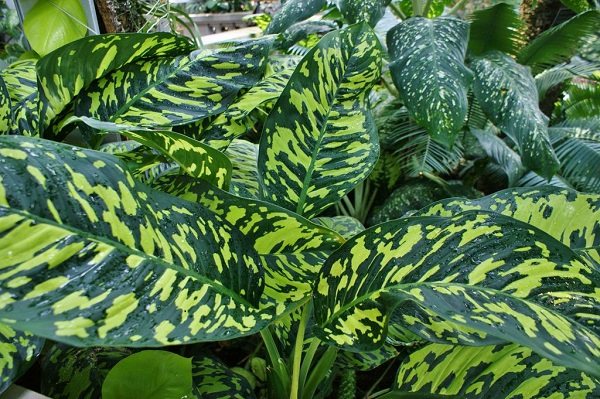

Leopold (Dieffenbachia Leipoldii Bull)
An extremely extraordinary shape: a trunk with a diameter of about 2 cm and a height of only 5 cm. Lateral shoots rise up to half a meter.
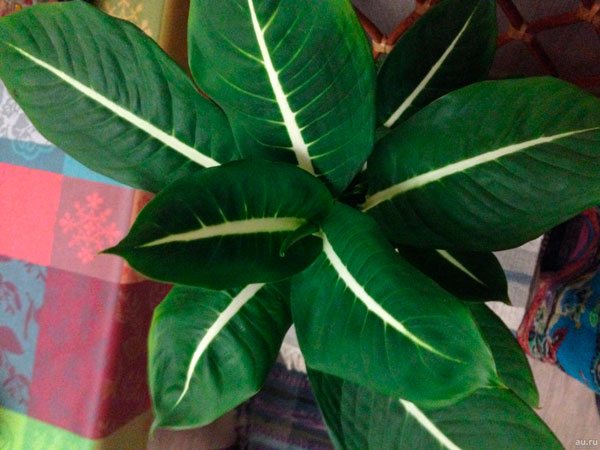

Dark green oblong ellipsoidal leaves of medium size: 35x15 cm. A pronounced light stripe runs along the central vein of the leaf plate.
Lovely, or pleasant (Dieffenbachia Amoena)
The oval leaves are distinguished by light stripes against a dark background. They radiate out radially from the center, staining each lateral vein. Fleshy, dense, woody stem reaches 1.5 m in height.
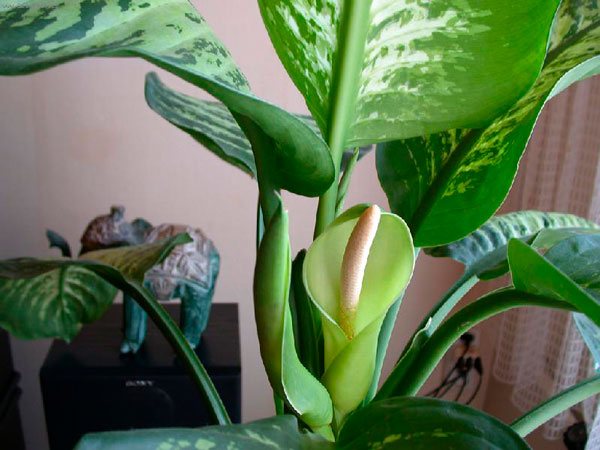

Attention! The species is hardy to unfavorable conditions: excessive darkening, dry air, high temperature, red spider mite infestation.
Seguina
Ovate or lanceolate leaves with a pointed tip (50x16 cm) are mottled with light spots close to the center. The central vein is dark green, like the leaf at the edges. The plant with a thick herbaceous stem reaches 50 cm in height.
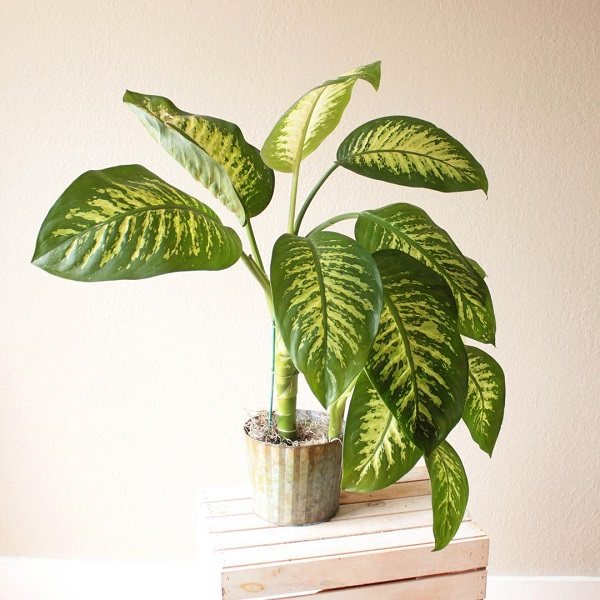

Oersted (Dieffenbachia Oerstedii)
The leaves are elongated, heart-shaped, 30–35 cm long. The pattern resembles Leopold's dieffenbachia, but there may be single light spots along the edges from the central light pronounced vein. The bush has a strong trunk up to 1.8 m.
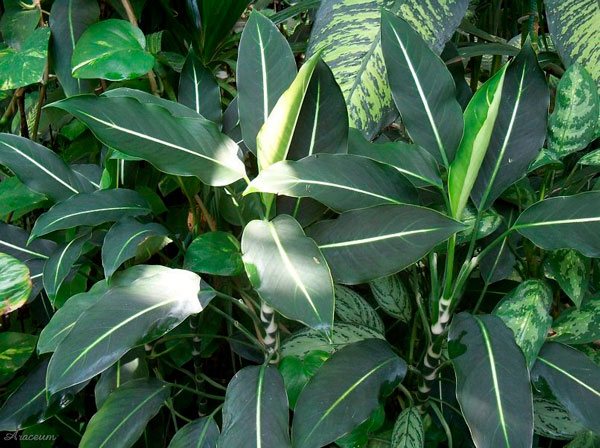

Attention! Oersteda is sensitive to minimal air pollution and needs a lot of light. Temperatures below +14 ° C are destructive for her.
Magnificent, or royal
International Latin name - Dieffenbachia Magnifica (Rex)
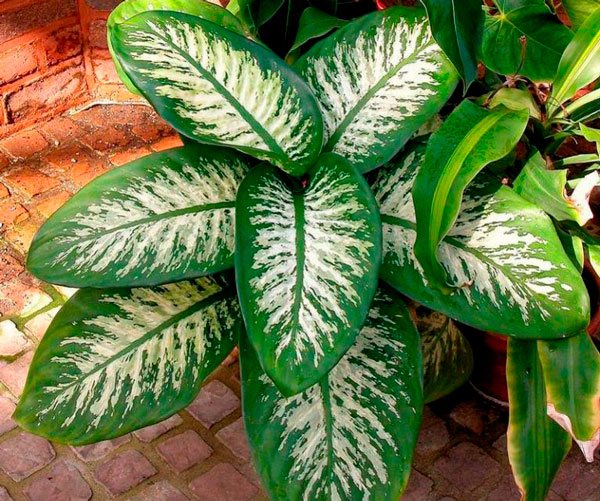

Leaves are oval, with a rounded tip, up to 40 cm in length, light green with white or yellowish dots. The stem is dense, up to 1 m.
It does not tolerate temperature changes, but it should be watered more often.
Vesuvius (Dieffenbachia Vesuvius)
Leaves are lanceolate, elongated, with a pointed tip. marble color: light green plate with dark green, yellowish and white spots.
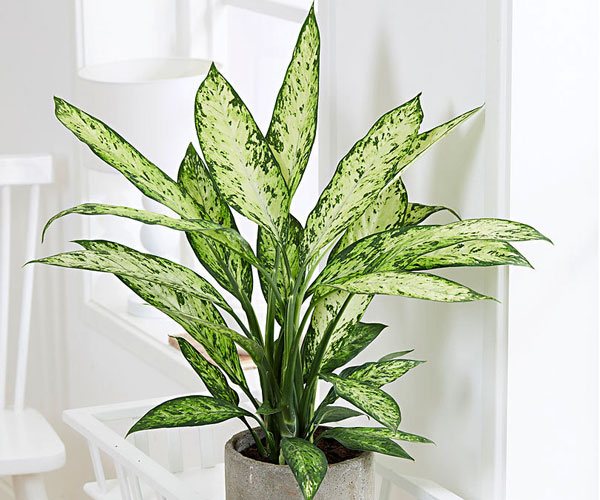

It is a bushy form, herbaceous stems, strong, resistant. Height 60-70 cm.
Camilla
Dieffenbachia Camilla has medium-sized lanceolate leaves, 35–40 x 15 cm. Interesting design: light creamy center with dark green edging.
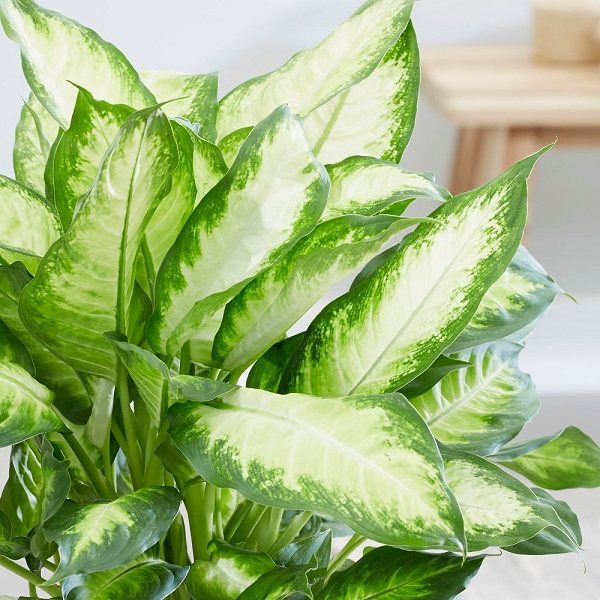

Bushy form, herbaceous stems, mobile. Grows up to 2 meters.
Dieffenbachia compact
On light green leaves with a light middle, there are dark green spots and the same edging. Lanceolate shape with an elongated pointed tip.
Dieffenbachia Maculata Compacta grows up to 55–65 cm, it is a bushy form with mobile herbaceous stems.
Large-leaved
Wide, ovoid, monochromatic leaves (up to 60 x 40 cm) give the name of this variety: Dieffenbachia Macrophylla. A powerful woody stem grows up to 1 m.
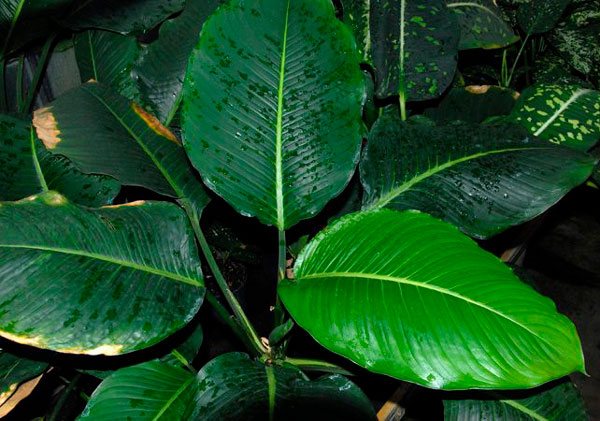

Attention! The juice of this large-leaved dieffenbachia has an unpleasant, pungent odor.
Bauman (Dieffenbachia Bowmannii)
Differs in incredible leaves: 70-80 cm in length. The plates are lanceolate, with an elongated-pointed tip, dark green with light blotches.
Bushy form, sturdy stems, up to 1–1.5 m in height.
Bause (Dieffenbachia Bausei)
Oval medium-sized, up to 40 cm, leaves with a slightly pointed tip. Pattern in the form of streaks of cream color with dark green spots. A strong, stable stem rarely exceeds 1 meter in height.
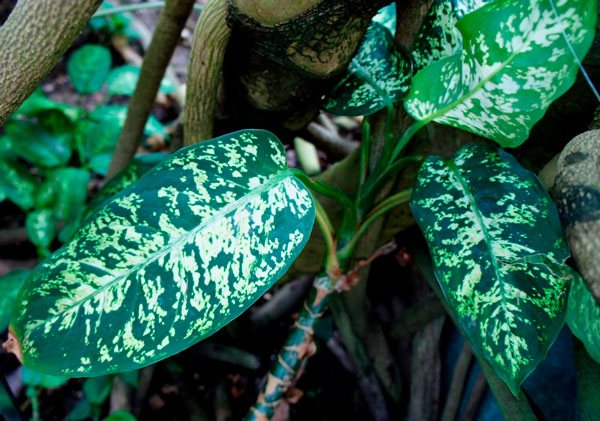

Feels unwell in the shade, does not tolerate temperatures below +10 ° C.
Dieffenbachia Tropic Snow
Light green foliage with light blurred spots. Ovate, slightly pointed tip, 50 x 30 cm. Stable stem up to 80 cm.
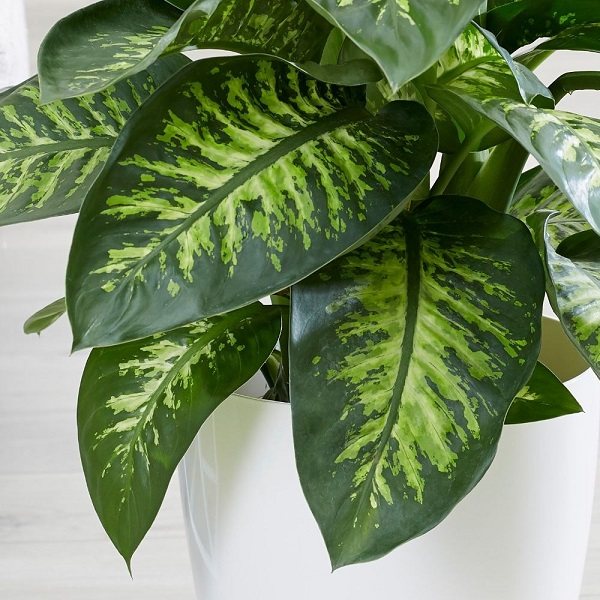

Green Magic
A distinctive feature of this species is the contrastingly colored central vein of all leaves. Against a dark green background, a light, almost white central stripe is very clearly visible even from a distance. Often it is complemented by the same light, but much thinner lateral veins. The background color is even, without spots typical for many other dieffenbachia.
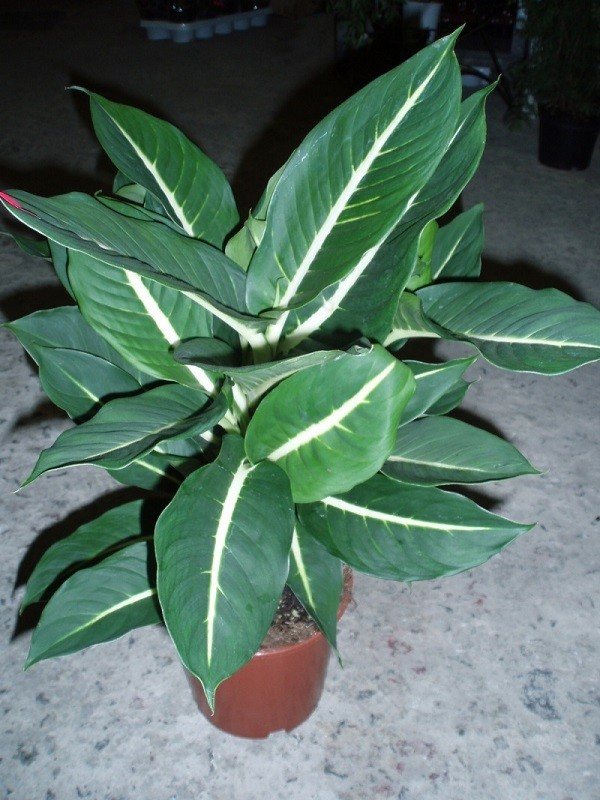

The Green Magic variety has large, dense, glossy leaves. Their shape is close to oval, with a more or less noticeable sharpening. The main color of the leaf plate is green, but its shade ranges from bright and juicy to dark, bluish.
Dieffenbachia allergy
What to do if dieffenbachia juice gets on the skin and causes an allergic reaction? Symptoms can be classified as local and general.
If a localized rash, itching, blisters appear, take antihistamines and monitor the body's reaction. If the further development of symptoms does not occur, then the following conclusions should be drawn:
- the impact was local;
- the next time the reaction will be more violent and unpredictable.
General symptoms occur with the development of acute respiratory and cardiovascular failure. The severity of the condition requires immediate hospitalization and intensive care in the intensive care unit.
Microclimate requirements
Dieffenbachia will not feel comfortable in every apartment. If the recommended microclimate for growing a houseplant is not observed in the room, then it is advisable not to rush to decorate the interior with the flower you like: it is not enough pleasure to keep a stunted and drooping representative of the flora in the apartment, while slowly growing and prone to disease.
- Lighting. Dieffenbachia, being a native of tropical countries, is photophilous, but does not like direct sunlight.
- Temperature.The best range is + 20 ° С ... + 26 ° С in summer and + 18 ° С ... + 19 ° С in winter, sharp temperature drops are extremely undesirable. Drafts can cause great harm.
- Humidity. The recommended level is at least 55%.
Knowing the physical parameters of the air in your apartment will help to determine in advance the appropriateness of the presence of dieffenbachia in your area.
Burns of the mucous membrane
A special case when toxic substances settle on the mucous membrane of the nose, mouth, larynx. Signs of dieffenbachia poisoning indicate acute respiratory failure:
- burning sensation, pain, perspiration;
- increased respiratory movements;
- dry wheezing cough;
- dyspnea.


If swelling of the mucous membrane causes obstruction of the airways, a threat to human life arises. Perhaps the appearance of symptoms of insufficient oxygen supply to the body:
- cyanosis of the skin;
- oppression of consciousness;
- lowering blood pressure;
- development of a terminal state.
It is necessary to immediately call an ambulance and before the arrival of medical specialists, do not leave the victim alone. Monitor his consciousness, breathing, blood pressure, heart rate. With the development of a terminal state, proceed to cardiopulmonary resuscitation.
When dieffenbachia juice gets into the eyes, a burn appears, the depth of which may vary. The severity depends on the concentration and time of exposure to the damaging factor. The victim may complain of pain, burning, swelling, inability to open the affected eye, watery eyes, and blurred vision.
What to do in case of eye burns with dieffenbachia juice?
- Rinse the cavity with a stream of water so that the liquid does not fall on the healthy side, applying a protective bandage to the uninjured eye (especially important for children).
- Seek medical attention immediately.


The trauma center will conduct a hardware and clinical examination. Only a medical professional can adequately assess the depth of the lesion. The doctor will prescribe a complex treatment - analgesics, if there are indications - antibacterial, healing drugs, physiotherapy procedures. If necessary, the victim is hospitalized in a hospital.
Features of the view
A common feature for all plants is a thick stem with large, oval leaves. In the wild, the inflorescence looks like an ear, but the house plant rarely blooms.
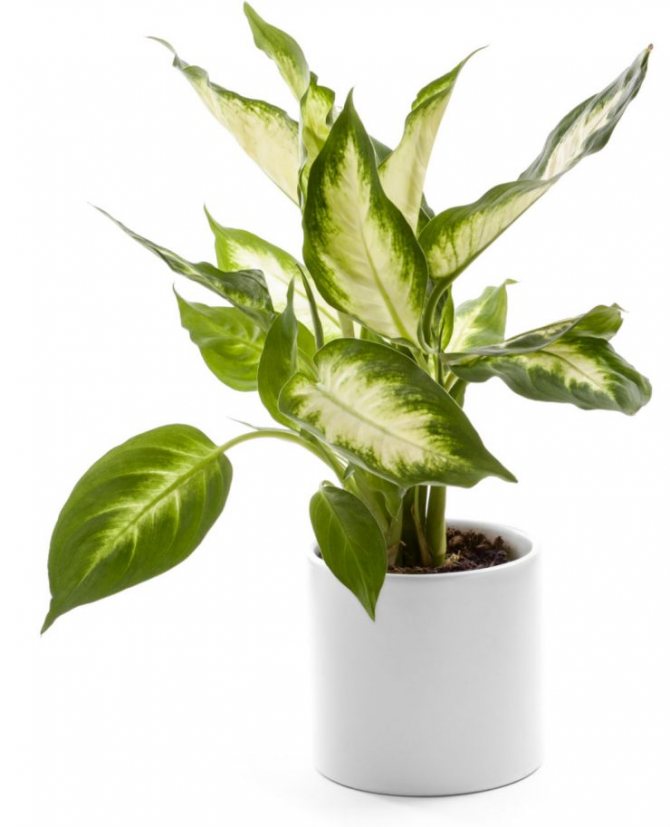

Despite the external appeal, care must be taken with this plant. It is poisonous, so all pruning and transplanting work must be carried out observing safety rules.
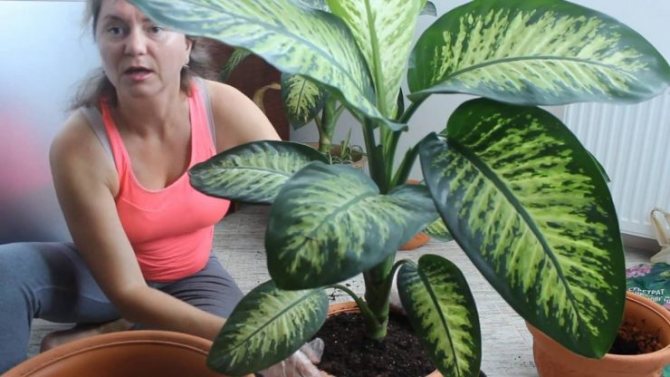

The dieffenbachia plant has a very vigorous growth. Under good conditions, new leaves appear every week, however, at the same time, the lower stem begins to bare, due to which the flower loses its decorative effect. To fix this, the plant needs to be pruned and re-rooted.
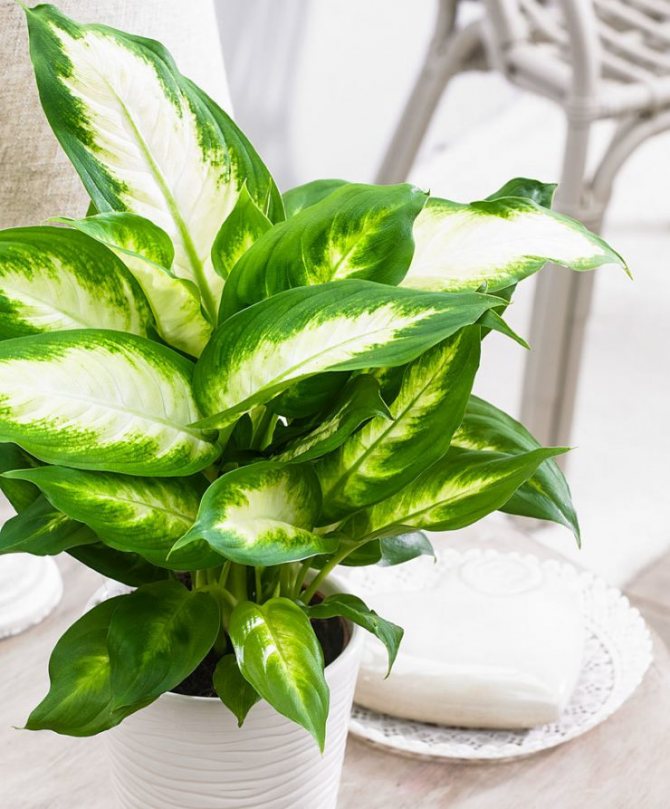

But there is also a small nuance here. Water for irrigation must be defended or filtered, since Dieffenbachia does not cope well with lime.
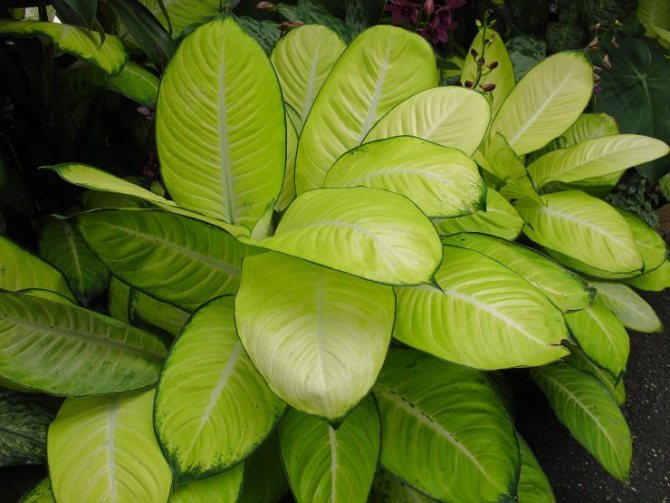

To contemplate the beauty of this plant at home, you will have to make a lot of effort.
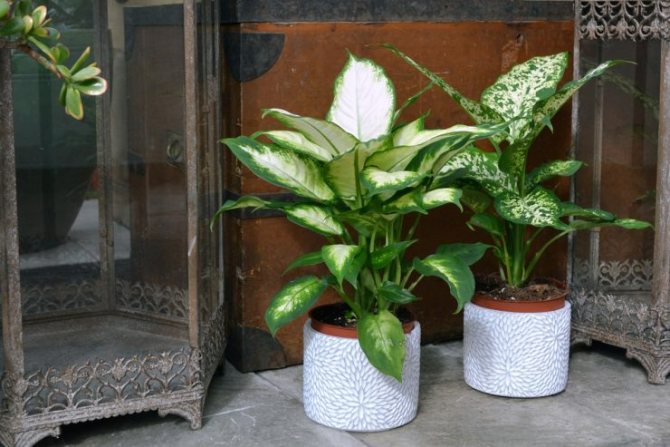

Pretty (D. amoena)
The leaves are noticeably elongated in length, compared to other species, they have a less pronounced rounded shape. The visiting card of this species is a very light pattern along the lateral veins, resembling a herringbone in shape. The contrast between the dark green edges and the background makes the plant very visible and attractive. In good light, the pattern is brighter and more noticeable.
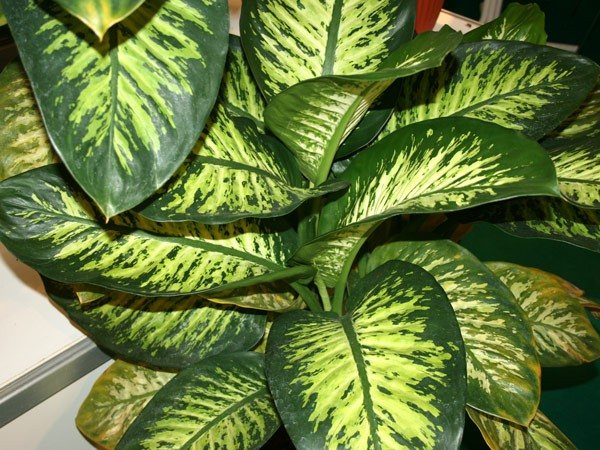

If white stripes, elongated spots and streaks occupy a significant area of the leaf, the variety is called "Tropic snow" (in the literature - Tropic snow).You can read more about Dieffenbachia adorable and its care here.
Rejuvenation
The exposed long trunk makes it uncomfortable to care for the plant, which requires additional support. In addition, decorativeness suffers greatly, because instead of a lush bush, a bare stem stretches upward.


There are two ways to restore the aesthetic appearance of Dieffenbachia:
- By pinching the growing point at the crown, which will likely awaken the dormant buds on the trunk and cause the flower to sprout.
- By cutting the crown off and then rooting it. To do this, the top is cut off approximately at a distance of a couple of centimeters from the node in which the sleeping buds are located. The oozing stem is blotted dry and sprinkled with activated charcoal. Then it can be planted in a new pot with loose, not water-absorbing soil. It is important not to flood the new plant in order to prevent root and trunk decay before the roots grow back. The remaining nodes of the long stem can be divided into cuttings and planted. From them new dieffenbachia will grow, indistinguishable from the mother.
Frequently asked questions about Dieffenbachia
Novice florists have many questions related to plant transplantation, care and placement in an apartment. People start a flower, and then they just begin to be interested in the conditions of detention, compatibility with other plants, and energy influence. Dieffenbachia is a difficult plant to care for and on a mental level. Not suitable for all people, not finding a common language with everyone.
Muzhegon and the flower of celibacy
Popular rumor ascribes to the plant the properties of "repelling" the stronger sex.
There is an opinion that if an unmarried lady acquires dieffenbachia, she will not be able to count on personal happiness. If there is a man in the house, he will leave or, even worse, die.
Bad omens don't come true if you don't believe in them. When you spit convulsively over your left shoulder at the sight of a black cat, you admit the thought that bad things will happen. And the Universe immediately throws up negative options for the development of events. Try to walk by without paying attention to the black beast, you will see, nothing bad will happen!
Why dieffenbachia is "crying"
In fact, it is a figurative expression. The plant, as mentioned above, is an excellent natural barometer. It reacts sensitively to the slightest changes in the weather. Before lingering showers and snowfalls, droplets of moisture appear on the leaves of dieffenbachia. You should not be afraid of this phenomenon, it only heralds an increase in the concentration of water in the air. Use this feature to know for sure if you need to grab an umbrella when leaving the house.
Where to put the plant
The space where people sleep is not the best place for dieffenbachia. At night, it actively emits carbon dioxide, so the next morning a person will feel sick.
This applies to all plants with large leaves, they are appropriate in the living room, kitchen and other places where you spend the day.
Believe the omens or not, it's a personal matter. I don’t believe in bad omens, but I don’t start a plant due to the presence of a cat and a dog. Responsible pet owners will never opt for this flower.
A little about
Ksenia Likhachevskaya Tarolog Esotericism for me is a universal key that opens many doors behind which new knowledge, opportunities and prospects are hidden. More than 20 years ago, I first picked up Tarot cards. Since then, I have used them not only for predictions. The world of Tarot is an amazing reality, immersed in which you will find answers to questions and be able to change your life. Tarot reading services
Interesting:
Other articles
- Divination 2019.08.13Tarot horoscope for September 2019 for Capricorns
- Divination 2019.08.13Tarot horoscope for September 2019 for Aquarius
- Divination 2019.08.13Tarot horoscope for September 2019 for Pisces
- Divination 2019.08.13Tarot horoscope for September 2019 for Aries
Tags: Ksenia Likhachevskaya, Signs
- Similar posts
- Signs about sneezing: divination by time, days of the week and the number of sneezes
- 27 will take about cats in the house
- Can geraniums be kept at home? Is there any benefit or only harm?
«Previous post

